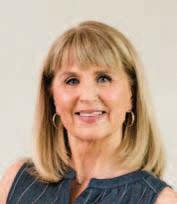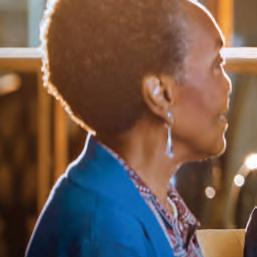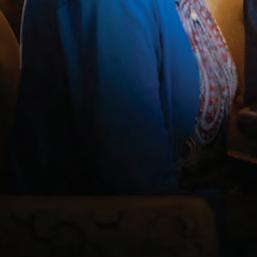
FOCUS FOR PEOPLE OVER 50
More than 200,000 readers throughout Greater Washington


More than 200,000 readers throughout Greater Washington
By Glenda C. Booth
The theme for this year’s Black History Month is “African Americans in Labor,” highlighting how African Americans helped build the United States — voluntarily and involuntarily.
Both free and enslaved African Americans constructed the U.S. Capitol, the White House and the Smithsonian Institution’s first building, the “Castle.” They laid out the first streets of the nation’s capital.
While George Washington was leading the Revolutionary War, he left his Virginia plantation, Mount Vernon, in the hands of enslaved men, women and children. As he fought, they were “keeping the home fires burning, pulling weeds, harvesting crops and running his fishery, distillery and spinning house. He could get rich while slaves got nothing,” said retired Washington, D.C., administrative law Judge Rohulamin Quander.
Quander, 81, has ancestors who were enslaved on George Washington’s Mount Vernon plantation. He has spent decades documenting the many contributions African Americans have made to the country — contributions too often overlooked.
“It’s so important to tell the truth about American history and the many ways African Americans have contributed to that history, literally and physically building that history,” Quander said.
Quander, who is from one of the oldest documented African American families in the United States, traces his family back 11 generations to the 1670s. Their surname originated with ancestor Egya Amkwandoh, who was kidnapped in Ghana in the 1600s and forcibly brought to America. When asked his name, he answered,


LEISURE & TRAVEL
Explore the Gulf Coast, “America’s Mediterranean,” or warm up in the British Virgin Islands page 26

ARTS & STYLE
“Amkwandoh,” which was misinterpreted as, “I am Quando.”
After being freed, some of the Quanders acquired land in Northern Virginia and Maryland. Today, four streets are named for the Quander family: one each in Virginia’s Fairfax County and Prince William County; one in Prince George’s County,
Maryland; and one in Washington, D.C.’s Navy Yard area.
The Quander family gathers every year for a reunion. This year’s will mark the
BLACK HISTORY, page 32






















Virginia professor publishes his eighth book; plus, Bob Levey on a late-life splurge page 30
Publisher Stuart Rosenthal is taking a sabbatical this month. His column will return in March.
All through school we are required to write. Writing makes us think. Getting us to write clearly is a significant goal of education.
There are now artificial intelligence (AI) programs that can create stories, novels, non-fictional books, answers to exams, blogs and whatever else you want to write.

They can generate ideas, edit and proofread. Even though they are relatively new, they are pretty good. Imagine how much better they will be in the next couple of years. It all sounds wonderful, except it leaves
BEACON BITS
Feb. 15
out what you gain by doing your own writing — exercising your brain and enhancing your ability to think and present your thoughts to others.
Let’s say Johnny took an English Lit class. He was required to write an article about Hamlet. He went to a frat party instead of doing the assignment.
By Ted Meyerson
No matter. He turned on his laptop, opened one of his three AI writing apps, and typed in Hamlet, Shakespeare, critical essay, 500 words, use Johnny’s style.
Before he could get over to the printer, the essay came out double spaced and printed on both sides. He turned in the
WASHINGTON
Alexandria’s annual George Washington Parade takes place on Sat., Feb. 15 from 2 to 4 p.m. It follows the traditional route along Fairfax and Royals streets. For more information, including parking, maps, route and status, visit washingtonbirthday.com or email gwbirthdayevents@gmail.com.

The Beacon is a monthly newspaper dedicated to inform, serve, and entertain the citizens of the Greater Washington DC area, and is privately owned. Other editions serve Greater Baltimore and Howard County, Md. Readership exceeds 400,000.
Subscriptions are available via first-class mail ($36) or third-class mail ($12), prepaid with order. D.C. and Maryland residents: add 6 percent for sales tax. Send subscription order to the office listed below.
Publication of advertising contained herein does not necessarily constitute endorsement. Signed columns represent the opinions of the writers, and not necessarily the opinion of the publisher.
Publisher/Editor – Stuart P. Rosenthal



President/Associate Publisher – Judith K. Rosenthal
Executive Vice President – Gordon Hasenei
Managing Editor – Margaret Foster
Art Director – Kyle Gregory
Vice President of Operations – Roger King
Advertising Representatives –
Dan Kelly, M.K. Phillips, Alan Spiegel
Assistant Editor – Ana Preger Hart
Editorial Intern – Tori Cleveland
The Beacon, P.O. Box 2227, Silver Spring, MD 20915 (301) 949-9766 • Email: info@thebeaconnewspapers.com
Website: www.theBeaconNewspapers.com
Submissions:
paper and got an A on the assignment.
Johnny couldn’t participate in the class discussion because he hadn’t read the play. Still, he passed the course because the essay was so good.
Johnny got through most of his college classes using AI to do his homework. His laptop passed more courses than he did. He graduated — but wasn’t educated.
Johnny got a job. He was enthusiastic and eager. He bought a new, more powerful laptop and loaded it with advanced AI writing programs.
Johnny’s boss called a meeting. Everyone at the conference table was as dependent on AI as Johnny. Even the boss used an AI program to research solutions to the company’s problems.
The issue under discussion was clear. Each person in the meeting put in some key words and was confident that the app would find a solution to the company crisis. It didn’t work.
Even though the AI programs could recover everything that had ever been posted on the internet, they couldn’t differentiate between good, bad, true or false. They couldn’t think. They lacked judgment.
Some of the solutions they came up with had proven disastrous for other companies. Other solutions were downright weird.
Nobody at the table had gotten out of education what education is supposed to offer — an enhanced ability to think and present ideas. I wonder if the company could survive with a laptop and computer app acting as CEO?
Taken to its logical conclusion, if AI becomes dominant and permissible, we might end up with smart laptops and nonthinking humans. Seems to me, we have enough non-thinking humans already.
Readers are encouraged to share their opinions on any matter addressed in the Beacon as well as on political and social issues of the day. Mail your Letter to the Editor to The Beacon, P.O. Box 2227, Silver Spring, MD 20915, or email to info@thebeaconnewspapers.com. Please include your name, address and telephone number for verification.
Dear Editor:
I normally enjoy the Beacon for its lively articles, but I was struck hard when reading the Letter to the Editor that you allowed to be published in the January issue. The letter writer, Richard Todd, totally tears down a woman, Joan Vassos, who was interviewed about her life after starring on the “Golden Bachelorette.”
Mr. Todd rips into her “ego,” implies that she and others “think the world revolves around them” and says we need “a more grown up role model.”
Such a harsh personal attack on Ms. Vassos never should have been printed. It left a sour note in my heart. She dealt with cancer and other challenges, and this letter did not seem fair.
People deserve respect. Especially older people who take risks like Ms. Vassos.
Martine Palmiter Rockville, MD
Dear Editor:
Your sparkling, upbeat story on the front page, “A Life of Music and Adventure,” was an inspirational winner — perfect for the new year, 2025. Betty Scott is a motivational charmer who has found the secret to what really keeps us young:
1. Don’t count the years
2. Have a spirit of adventure
3. Go out and get things done 4. Age equals experience and is a big plus
5. Energy, joy and spirit will uplift you Betty Scott is a wow! And Bob Levey’s Nash Rambler column nicely bookended your winning January issue. Great beginning for 2025.
Richard K. Todd Washington, DC
Dear Editor:
I appreciated your column and memory of the “husky” department in children’s clothing stores (From the Publisher, January 2025). I share a similar memory. Unfortunately, it took me 40+ years to go from husky to a shopper in the “regular” section of the department store.
Glenn Easton Clarksburg, MD
Dear Editor:
As invaluable as all the new technology is, I have found a rather disconcerting, albeit unintentional, adverse effect when I telephone someone rather than text.
Most of the time the individual who I call invariably sounds annoyed.
I’m always taken aback by such a response because I can’t help wonder why anyone would answer their phone if they are not fully available to do so. That’s why there is voicemail!
Dale Ingrid Barnhard Via email








WINTER WARNING
More heart attacks strike in cold weather and during snow shoveling
JUNK FOOD HAZE
Chips, cereal, candy and other processed foods can affect the brain
HEARING STUDY
If you have normal or impaired hearing, help invent a new test in a two-hour study
COOK AT HOME
Home-cooked meals usually have less salt and butter than restaurant fare
By Lauran Neergaard
About a million Americans a year are expected to develop dementia by 2060, roughly double today’s toll, researchers reported in January.
That estimate is based on a new study that found a higher lifetime risk than previously thought: After age 55, people have up to a 4 in 10 chance of eventually developing dementia — if they live long enough. It’s a sobering number, but there are steps people can take to reduce that risk, such as controlling high blood pressure and other bad-for-the-brain health problems. And it’s not too late to try even in middle age.
“All of our research suggests what you do in midlife really matters,” said Dr. Josef Coresh of NYU Langone Health, who coauthored the study in the journal Nature Medicine
Dementia isn’t only Alzheimer’s
Taking longer to recall a name or where you put your keys is typical with older age. But dementia isn’t a normal part of aging — it’s a progressive loss of memory, language and other cognitive functions. Sim-
ply getting older is the biggest risk, and the population is rapidly aging.
Alzheimer’s is the most common form, and silent brain changes that eventually lead to it can begin two decades before symptoms appear.
Other types include vascular dementia when heart disease or small strokes impair blood flow to the brain. Many people have mixed causes, meaning vascular problems could exacerbate brewing Alzheimer’s symptoms.
Measuring the risk from a certain age over the potential remaining life span can guide public health recommendations and medical research.
“It’s not a guarantee that someone will develop dementia,” cautioned Dr. James Galvin, a University of Miami Alzheimer’s specialist. He wasn’t involved with the new study but said the findings fit with other research.
Dementia risk is different by age
Prior studies estimated about 14% of men and 23% of women would develop some form of dementia during their lifetime.
Coresh’s team analyzed more recent data from a U.S. study that has tracked the heart health and cognitive function of about 15,000 older adults for several decades.
Importantly, they found the risk changes with the decades. Only 4% of people developed dementia between the ages of 55 and 75, what Coresh calls a key 20year window for protecting brain health. For people who survive common health threats until 75, the dementia risk then jumped — to 20% by age 85 and 42% between ages 85 and 95.
Overall, the lifetime dementia risk after age 55 was 35% for men and 48% for women, the researchers concluded. Women generally live longer than men, a main reason for that difference, Coresh noted. Black Americans had a slightly higher risk, 44%, than white people at 41%.
There are some risk factors people can’t control, including age and whether you inherited a gene variant called APOE4 that raises the chances of late-in-life Alzheimer’s.
But people can try to avert or at least
delay health problems that contribute to later dementia. Coresh, for example, wears a helmet when biking because repeated or severe brain injuries from crashes or falls increase the risk of later-in-life dementia.
Especially important: “What’s good for your heart is good for your brain,” added Miami’s Galvin. He urges people to exercise, avoid obesity, and control blood pressure, diabetes and cholesterol.
For example, high blood pressure can impair blood flow to the brain, a risk not just for vascular dementia but also linked to some hallmarks of Alzheimer’s.
Similarly, the high blood sugar of poorly controlled diabetes is linked to cognitive decline and damaging inflammation in the brain.
Stay socially and cognitively active, too, Galvin said. He urges people to try hearing aids if age brings hearing loss, which can spur social isolation.
“There are things that we have control over, and those things I think would be really, really important to build a better brain as we age,” he said.
By Heidi Godman
Nantucket, a beautiful, 14-mile-long island off the coast of Massachusetts, has a 40-point resiliency plan to help withstand climate change.
Perhaps we can all benefit from creating individual resilience plans to help handle the big and small issues that erode our sense of well-being. But what is resilience, and how do you cultivate it?
Resilience is a psychological response that helps you adapt to life’s difficulties and seek a path forward through challenges.
“It’s a flexible mindset that helps you adapt, think critically and stay focused on your values and what matters most,” said Luana Marques, an associate professor of psychiatry at Harvard Medical School.
While everyone has the ability to be resilient, your capacity for resilience can take a beating over time from chronic stress, perhaps from financial instability or staying in a job you dislike. The longer you’re in that situation, the harder it becomes to cope with it.
Fortunately, it’s possible to cultivate resilience. To do so, it helps to exercise resiliency skills as often as possible, even for minor stressors. Marques recommends the following strategies:
In stressful situations, try to balance out your thoughts by adopting a broader perspective. “This will help you stop using the emotional part of your brain and start using the thinking part of your brain. For example, if you’re asking for a raise and your brain said you won’t get it, think about the things you’ve done that are worthy of a raise. You’ll slow down the emotional response and shift your mindset from anxious to action,” Marques said.
“When you’re anxious, stressed or burned out, you tend to avoid things that make you uncomfortable. That can make you feel stuck,” Marques said. “What you need to do is get out of your comfort zone
and take a step toward the thing you want, in spite of fear.”
For example, if you’re afraid of giving a presentation, practice it with friends. If you’re having conflict at home, don’t walk away from your partner — schedule time to talk about what’s making you upset.
“Stress happens when your actions are not aligned with your values — the things that matter most to you or bring you joy. For example, you might feel stressed if you care most about your family but can’t be there for dinner, or care most about your health but drink a lot,” she said.
She suggests that you identify your top three values and make sure your daily actions align with them. If being with family is one of the three, make your time with them a priority. If you get joy from a clean house, make daily tidying a priority.
Practice these shift, approach and align
strategies throughout the week. “One trick I use is looking at my calendar on Sunday and checking if my actions for the week are aligned with my values. If they aren’t, I try to change things around,” Marques said.
It’s also important to live as healthy a lifestyle as possible, which will help keep your brain functioning at its best.
Healthy lifestyle habits include:
• getting seven to nine hours of sleep per night
• following a healthy diet, such as a Mediterranean-style diet
• aiming for at least 150 minutes of moderate-intensity activities (such as brisk walking) each week — and adding on strength training at least twice a week
• if you drink alcohol, limiting yourself to no more than one drink per day for women and two drinks per day for men
• not smoking
• staying socially connected, whether in
By Kristen N. Smith
Probiotics are live microorganisms that provide health benefits when consumed in adequate amounts. Found in fermented foods and supplements, these beneficial bacteria are particularly renowned for their role in promoting gut health, enhancing immune function and supporting overall well-being.
Probiotics are most commonly associated with improved gut health. The human gut contains trillions of bacteria, collectively known as the gut microbiota, which play a crucial role in digestion, nutrient absorption and overall gastrointestinal health.
Probiotics help maintain a healthy bal-
From page 4
person, by phone or video calls, social media or text messages.
Need resilience training?
Even the best athletes have coaches, and you might benefit from resilience training.
Consider taking an online course, such as the one developed by Marques (“HarvardX: Building Personal Resilience: Managing Anxiety and Mental Health,” avail-
ance of gut bacteria, especially after disruptions caused by antibiotics (which kill off good as well as bad bacteria) or illness.
Research shows that probiotics can alleviate symptoms of gastrointestinal disorders. Additionally, probiotics can help prevent and treat diarrhea, including traveler’s and antibiotic-associated diarrhea.
Immune system support
Probiotics also play a significant role in strengthening the immune system. Since the gut is home to a substantial portion of
For free materials about area housing communities, just complete and clip this coupon and mail, or take a picture and email it to the Beacon
District of Columbia
❏ Chevy Chase House (See ad on page 6)
❏ Brooke Grove (See ad on page 11)
able at edx.org). Or maybe turn to a therapist online or in person for help. Look for someone who specializes in cognitive behavioral therapy, which guides you to redirect negative thoughts to positive or productive ones.
Practicing as you face day-to-day stresses will help you hone skills to help navigate when dark clouds roll in and seas get rough.
Heidi Godman is executive editor of Harvard Health Letter
© 2024 Harvard University. Distributed by Tribune Content Agency, LLC.

❏ Cascades at Frederick (See ad on page 15)
❏ Charles E. Smith Life Communities (See ad on page 9)
❏ Churchill Senior Living (See ad on page 17)
❏ Grandview, The/Erickson (See ad on page 3)
❏ Homecrest House (See ad on page 12)
❏ Park View Bladensburg (See ad on page 25)
❏ Park View Columbia (See ad on page 25)
❏ Park View Emerson (See ad on page 25)
❏ Park View Laurel (See ad on page 25)
❏ Riderwood/Erickson (See ad on page 3)
❏ Willow Manor at Cabin Branch (See ad on page 23)
❏ Willow Manor at Colesville (See ad on page 16)
❏ Ashby Ponds/Erickson (See ad on page 3)
❏ Culpepper Garden (See ad on page 13)
❏ Falcons Landing (See ad on page 40)
❏ Greenspring/Erickson (See ad on page 3)
❏ Woodleigh Chase/Erickson (See ad on page 3)
❏ Hearing & Brain Study (See ad and article on page 12)
Check the boxes you’re interested in and return this form to: The Beacon, P.O. Box 2227, Silver Spring, MD 20915 or take a picture and email to housing@thebeaconnewspapers.com.
By Howard LeWine, M.D.
Q: Why do everyday activities become more of a struggle later in life?
A: As we age, our bodies go through changes that can affect strength, flexibility and overall mobility, often starting earlier than expected. Here are some age-related changes to be aware of:
Muscles shrink. Muscle loss begins in your mid-30s at a rate of 1% to 2% a year. While that may not sound like much, these little changes make a difference over the years, contributing to achy joints, injuries and weight gain — all of which can make daily activities more challenging. As you get into your 60s and 70s, muscle loss can accelerate to as much as 3% a year.
Strength wanes. One result of muscle loss is a decrease in strength, making ac-
From page 5
the body’s immune cells, maintaining a healthy gut microbiota is crucial for optimal immune function.
Probiotics enhance the production of natural antibodies and stimulate immune cells like macrophages and T-lymphocytes. This immune-boosting effect can reduce the frequency and severity of infections.


tivities like walking, getting out of a chair or climbing stairs more difficult. Beginning in your mid-30s, you lose about 1.5% of your strength a year, and that rate accelerates as you get older.
Power declines. As muscles shrink, you lose not only strength but also power, your body’s ability to exert force or strength quickly. Power plummets at more than twice the rate of strength — 3.5% a year for power compared to 1.5% for strength. Reductions in power make it harder to get across a street before the light changes, hoist a heavy bag of groceries, or catch yourself when you stumble.
Aerobic capacity decreases. A 25year-old heart can pump 2.5 quarts of blood a minute, but after age 30, heart and lung function begin to decline at a rate of about
Probiotics may also support metabolic health by improving insulin sensitivity and reducing inflammation, which are critical factors in managing conditions like obesity and type 2 diabetes.
Research suggests that probiotics may help lower blood cholesterol levels and regulate blood sugar.
Adding probiotics to your diet is pretty


10% per decade. A 65-year-old heart pumps about 1.5 quarts of blood a minute. The capacity drops to about 1 quart for 80-yearolds. These changes affect your endurance.
Joints stiffen. A decrease in flexibility and range of motion makes tasks like reaching overhead and stooping down problematic. Nearly 20% of older adults have difficulty reaching something on a high shelf, while 51% are challenged when they drop something and have to bend down to pick it up. Flexibility in the hip and shoulder joints declines about six degrees per decade from age 55 to 85.
Balance wobbles . According to a study in the British Journal of Sports Medicine, 54% of people in their early to mid-70s weren’t able to balance on one leg for 10 seconds without holding on to some-
simple: use foods and/or supplements.
Natural sources include fermented foods like yogurt, kefir, sauerkraut, kimchi, miso and tempeh. When selecting probiotic-rich foods, check for labels indicating live and active cultures.
Probiotic supplements are also available in various forms, including capsules, tablets and powders. Choose a product that specifies the strains included and the number of colony-forming units (CFUs), which typically range from one to 10 billion CFUs per dose.
thing. As you become less steady on your feet, tasks like going downstairs, navigating around obstacles and traversing uneven surfaces become more difficult, and you’re more likely to fall.
Functional fitness is a powerful tool for maintaining strength, mobility, and independence as you age. By staying active and following safety guidelines, you can slow down some of these age-related changes and continue to enjoy a healthy, fulfilling lifestyle well into your later years.
Howard LeWine, M.D., is an internist at Brigham and Women’s Hospital in Boston and assistant professor at Harvard Medical School. For additional consumer health information, see health.harvard.edu. © 2024 Harvard University. Distributed by Tribune Content Agency, LLC.
Incorporating probiotics into your diet may provide benefits, from improving gut health and supporting the immune system to enhancing metabolic health. Always consult with your healthcare provider before starting any new supplement regimen. Reprinted with permission from Environmental Nutrition, a monthly publication of Belvoir Media Group, LLC. © 2024 Belvoir Media Group. Distributed by Tribune Content Agency, LLC.
































Dear Savvy Senior,
I’ve heard that people with heart problems need to be extra careful during the winter months because heart attacks are much more common. What can you tell me about this?
—AFib Alan
Dear Alan,
Everyone knows winter is cold and flu season, but many don’t know that it’s also the prime season for heart attacks too, especially if you already have a heart condition or have suffered a previous heart attack.

By Jim Miller
In the U.S., the risk of having a heart attack during the winter months is twice as high as it is during the summertime. Why?
There are a number of factors, and they’re not all linked to cold weather. Even people who live in warm climates have an increased risk. Here are the areas you need to pay extra attention to this winter.
Cold temperatures: When a person gets cold, the body responds by constricting the blood vessels to help the body maintain heat. This causes blood pressure to go up and makes the heart work harder. Cold temperatures can also increase levels of certain proteins that can thicken the blood and increase the risk for blood clots. So, stay warm this winter. When you do have to go outside, make sure you bundle up in layers with gloves and a hat, and place a scarf over your mouth and nose to warm the air before you breathe it in.
Snow shoveling: Studies have shown that heart attack rates jump dramatically in the first few days after a major snowstorm, usually as a result of snow shoveling. Shoveling snow is a very strenuous activity that raises blood pressure and stresses the heart. Combine those factors with cold temperatures, and the risk for heart attack surges. If your sidewalk or driveway needs shoveling this winter, hire a kid from the neighborhood to do it for you, or use a snow blower. Or, if you must shovel, push rather than lift the snow as much as possible, stay warm, and take frequent breaks.
New Year’s resolutions: Every Jan. 1, millions of people join gyms or start exercise programs as part of their New Year’s resolution to get in shape, and many overexert themselves too soon. If you’re starting a new exercise program this winter, take the time to talk to your doctor about what types and how much exercise may be appropriate for you.
Winter weight gain: People tend to eat and drink more and gain more weight during the holiday season and winter months, all of which are hard on the heart and risky for someone with heart disease. So, keep a watchful eye on your diet this winter and avoid binging on fatty foods and alcohol.
Shorter days: Less daylight in the winter months can cause many people to develop seasonal affective disorder (SAD), a win-











tertime depression that can stress the heart. Studies have also looked at heart attack patients and found they usually have lower levels of vitamin D (which comes from sunlight) than people with healthy hearts. To boost your vitamin D this winter, consider taking a supplement that contains between 1,000 and 2,000 international units (IU) per day.
Flu season: Studies show that people who get flu shots have a lower heart attack risk. The inflammatory reaction set off by a flu infection can increase blood clotting,
which can lead to heart attacks in vulnerable people.
Get an annual flu shot and Covid-19 booster for protection. And, if you’ve never been vaccinated for RSV or pneumococcal pneumonia, you should consider getting these vaccines too.
Send your senior questions to: Savvy Senior, P.O. Box 5443, Norman, OK 73070, or visit SavvySenior.org. Jim Miller is a contributor to the NBC Today show and author of The Savvy Senior book.


•
•
•










By Kenya Hunter
The majority of strokes could be prevented, according to new guidelines released last fall that are aimed at helping people and their doctors do just that.
Stroke was the fourth leading cause of death in the U.S. in 2023, according to the Centers for Disease Control and Prevention, and more than half a million Americans have a stroke every year. But up to 80% of strokes may be preventable with better nutrition, exercise and identification of risk factors.
The first new guidelines on stroke prevention in 10 years from the American Stroke Association, a division of the American Heart Association, include recommendations for people and doctors that reflect a better understanding of who gets strokes and why, along with new drugs that can help reduce risk.
The good news is that the best way to reduce your risk for stroke is also the best way to reduce your risk for a whole host of health problems — eat a healthy diet, move your body and don’t smoke. The bad news is that it’s not always so easy to sustain.
A stroke happens when blood flow to part of the brain is blocked or if a blood vessel in the brain bursts. This deprives the brain of oxygen, which can cause brain damage that can lead to difficulty thinking, talking and walking, or even death.
Eating healthy foods can help control several factors that increase your risk for stroke, including high cholesterol, high blood sugar, and obesity, according to the Heart Association.
The group recommends foods in the socalled Mediterranean diet, such as fruits, vegetables, whole grains and olive oil, which can help keep cholesterol levels down. It suggests limiting red meat and other sources of saturated fat. Instead, get your protein from beans, nuts, poultry, fish and seafood.
Limit highly processed foods and drinks with a lot of added sugar. This can also reduce your calorie intake, which helps keep weight in check.
Health experts say walking is an easy way to improve physical and mental health, bolster fitness and prevent disease. Getting up and walking around for at least 10 minutes a day can “drastically” reduce your risk, said Dr. Cheryl Bushnell, a
Are you a DC senior who owned or rented a home, apartment or condo and lived there for all of 2024?
Don’t forget to file your 2024 DC tax return or a Schedule H form with the DC Office of Tax and Return to see if you qualify for this credit.

neurologist at Wake Forest University School of Medicine who was part of the group that came up with the new guidelines. Among the many benefits: Regular exercise can help reduce blood pressure, a major risk factor for stroke.
Of course, more is better: The heart association recommends at least 150 minutes of moderate aerobic or 75 minutes of vigorous activity — or some combination — per week. How you do it doesn’t matter so much, experts said: Go to the gym, take a walk or run in your neighborhood or use treadmills or stepper machines at home.
Diet and exercise can help control weight, another important risk factor for strokes. But a new class of drugs that can drastically reduce weight has been approved by regulators, providing new tools to reduce stroke risk since guidelines were last updated.
The guidelines now recommend that doctors consider prescribing these drugs, including those sold under the brand names Ozempic, Wegovy, Mounjaro and Zepbound, to people with obesity or diabetes.
While those drugs can help, people still need to eat well and exercise.
The new guidelines for the first time recommend doctors screen patients for other factors that could increase stroke risk, including sex and gender and nonmedical factors such as economic stability, access to health care, discrimination and racism.
For example, the risk of having a first stroke is nearly twice as high for Black adults in the U.S. as it is for white adults, according to the CDC.
“If somebody doesn’t have insurance or they can’t get to a doctor’s office because of transportation issues or they can’t get off work to get healthcare ... these are all things that can impact the ability to prevent stroke,” Bushnell said.
The guidelines also now recommend doctors should screen for conditions that could increase a woman’s risk for stroke, such as high blood pressure during pregnancy or early menopause.
Three of the most common stroke symptoms include face weakness, arm weakness and difficulty speaking. Brain damage can happen quickly but can be limited if a stroke is treated quickly. Stroke experts have coined an acronym to help you remember: FAST. F for face, A for arm, S for speech, and T for time. If you think you or a loved one could be having a stroke, call 911 right away.

By Andrew E. Budson, M.D.
Americans love their ultra-processed foods, whether they come as cereal (like Cap’n Crunch, a favorite of mine as a kid), snack foods (like Cheetos), entrees (like hot dogs) or desserts (like Twinkies).
Sure, loading your plate with vegetables, fruits, fish, healthful oils and grains in a Mediterranean-style diet boosts heart and brain health. But if you also eat some ultra-processed foods, is that bad for your brain health?
What to know about the study
A recent study appears to deliver a resounding yes. Eating ultra-processed foods (UPFs) is linked to a greater risk of cognitive impairment and strokes.
This observational study examined data from the REGARDS (REasons for Geographic And Racial Differences in Stroke) project, a longitudinal study of non-Hispanic Black and white Americans ages 45 years and older.
Study participants were initially enrolled between 2003 and 2007 and were given a number of questionnaires evaluating health, diet, exercise, body mass index, education, income, alcohol use, mood and other factors. In addition, tests of memory and language were adminis-

tered at regular intervals.
To examine the risk of stroke and cognitive impairment, data from 20,243 and 14,175 participants, respectively, were found usable based on the quality of the information from the questionnaires and tests. Approximately one-third of the sample identified as Black, and the majority of the remaining two-thirds identified as white.
• According to the study authors’ analysis, increasing the intake of ultraprocessed foods by just 10% was associated with a significantly greater risk of cognitive impairment and stroke.
• Intake of unprocessed or minimally processed foods was associated with a lower risk of cognitive impairment.
• The effect of ultra-processed foods on stroke risk was greater for individuals who identified as Black compared to individuals who identified as white.
Study participants who reported following a healthy diet (like a Mediterranean, DASH or MIND diet) and consumed minimal ultra-processed foods appeared to maintain better brain health compared to those who followed similar healthy diets but had more ultraprocessed foods.


Here are some biologically plausible reasons:
—UPFs are generally composed of processed carbohydrates that are very quickly broken down into simple sugars, equivalent to eating lots of candy. These sugar loads cause spikes of insulin, which can alter normal brain cell function.
—Eating ultra-processed foods is associated with a higher risk of metabolic syndrome and obesity, well-established conditions linked to high blood pressure, abnormal blood lipid levels, and Type 2 diabetes.
—There are unhealthy additives in ultra-processed foods that change the texture, color, sweetness or flavor. These additives disrupt the microbiome in the gut and can lead to gut inflammation, which can cause:
• the production of microbiome-produced metabolites that can affect brain function (such as short-chain fatty acids and lipopolysaccharides)
• leaky gut, allowing toxins and inflammatory molecules to enter the bloodstream and go to the brain
• altered neurotransmitter function (such as serotonin) that can impact mood and cognition directly
• increased cortisol levels that mimic

being under chronic stress, which can directly impact hippocampal and frontal lobe function, affecting memory and executivefunction performance, respectively
• an increased risk for Alzheimer’s, Parkinson’s and other neurodegenerative diseases due to inflammatory molecules traveling from the gut to the brain.
Because ultra-processed foods have poor nutritional value, people will often be hungry shortly after eating them, leading to overeating and its consequences.
Avoid processed foods, which can include chips and other snack foods, industrial breads and pastries, packaged sweets and candy, sugar-sweetened and diet sodas, instant noodles and soups, ready-toeat meals and frozen dinners, and processed meats such as hot dogs and bologna.
Instead, eat unprocessed or minimally processed foods, which, combined with a healthy Mediterranean menu, include fish, olive oil, avocados, whole fruits and vegetables, nuts and beans, and whole grains.
Andrew E. Budson, M.D., is a contributor to Health Publishing and an Editorial Advisory Board member.
© 2024 Harvard University. Distributed by Tribune Content Agency, LLC.
Join feat and Sch











jour focu boo tran dem Sch
nusforaninsightfulevent turingcaregivingadvocate dcommunityeducatorCarolyn ickasshesharesherpersonal rneyofcaringforherparents, usingonhowJoleneBrackey’s ok, o of t C CrreatingMoments s offJJoy y, nsformedherapproachto mentiacare. ickwilldiscussthebook’s cticalstrategiesforcreating aningfulmomentswith f edones faacingAlzheimer’s spectivesforcaregivers kingtoenhancethequality ifeforthoseintheircare. nchwillbeserved.
By Kristin Karim, M.D.
Dear Mayo Clinic: I’m a homebuilder and have begun experiencing numbness and tingling in my hands. Sometimes I drop things because I can’t get a good grip. A friend suggested I might have carpal tunnel syndrome. But doesn’t that mostly affect people who use computers all day? Can you explain more about the condition?
A: Carpal tunnel is a condition caused by compression of the median nerve located in the wrist. This nerve provides feeling to the thumb and the index, middle and part of the ring fingers, and also sends signals to the muscles around the base of the thumb. Some causes of carpal tunnel syndrome
include medical conditions such as arthritis, gout, diabetes, amyloidosis, infections, masses and severe wrist injuries. Other causes are environmental or workplace conditions that involve forceful and repetitive gripping, and using heavy machinery and vibrating manual tools.
The symptoms of carpal tunnel syndrome include:
• Numbness and tingling in the fingers
• Swelling and discomfort of the hands and fingers
• Weakness, especially when pinching and gripping
• Dropping things
• Waking up at night to shake out the hands
• Numbness of the fingers first thing in the morning
To determine if you have carpal tunnel syndrome, an orthopedic specialist will discuss the history of your symptoms and perform a physical examination of your hands and wrists. Other tests may be performed or requested, including:
• Two-point discrimination test on your fingertips to identify which fingers have decreased sensation
• Tinel’s test, which is taps the nerve in the carpal tunnel at the wrist to see if it causes tingling in your fingers
There are no proven strategies to prevent carpal tunnel syndrome, but you can minimize stress on hands and wrists by:
• Reducing your force and relaxing your grip. If your work involves a cash register or keyboard, for instance, hit the keys softly.
• Taking short, frequent breaks. Gently stretch and bend hands and wrists periodically. Alternate tasks when possible. Even a few minutes each hour can make a difference.
• Watching your form. Avoid bending your wrist all the way up or down. A relaxed middle position is best.

• Durkan’s test, which involves pressing a thumb over the nerve in the carpal tunnel at the wrist to see if the numbness or tingling gets worse
• X-rays of your affected hand
Nonsurgical treatments include wearing a wrist brace during the night and undergoing cortisone injections.





Surgical intervention for carpal tunnel syndrome is a carpal tunnel release. The roof of the carpal tunnel is divided, which relieves pressure on the median nerve. Surgery may be open or endoscopic.
• Improving your posture. Incorrect posture rolls shoulders forward, shortening the neck and shoulder muscles and compressing nerves in the neck. This can affect the wrists, fingers and hands, and can cause neck pain.
• Keeping your hands warm. You’re more likely to develop hand pain and stiffness if you work in a cold environment. If you’re experiencing symptoms, consult with an orthopedic surgeon.
© 2024 Mayo Foundation for Medical Education and Research. All Rights Reserved. Distributed by Tribune Content Agency, LLC.













































































As experts in senior care, Brooke Grove Retirement Village is pleased to offer seminars and classes that promote physical, spiritual and mental well-being.













All programs will be held in-person in the Gathering Room at Brooke Grove Rehabilitation and Nursing Center, located at 18131 Slade School Road on the Sandy Spring, Maryland, campus of Brooke Grove Retirement Village. Register as indicated below or contact Toni Davis at tdavis@bgf.org with questions.


PARKINSON’S EXERCISE GROUP




Offered in partnership with the Parkinson Foundation of the National Capital Area



MONDAYS & WEDNESDAYS 12 NOON–1 P.M.




This ongoing class for those with Parkinson’s or other neurogenerative disorders aims to improve posture, balance and circulation while also increasing strength, muscle control and mobility.
FREE with $50 annual PFNCA administrative fee. To register, visit: bit.ly/BGRVParkExercise
LIVING WELL SEMINAR: “BOOST YOUR BRAIN AND YOUR MOOD”
THURSDAY, FEBRUARY 13 • 10:30-11:45 A.M.
Every day and from moment to moment, we are all improvising our lives. Learning a few “improv” techniques can help boost brain health, illuminate possibilities and foster creative expression.
Join Brooke Grove and learn how to utilize the skills of improv in your everyday life. Outside worries will melt away as you play improv games and laugh with others in a relaxing and supportive atmosphere.
You don’t have to be a comedian or a performer to enjoy this workshop, led by Topher Bellavia.
FREE. To register, visit: bit.ly/BrainBoostBG





HEALTHY LIVING CLASS: “BALANCED BODY, BALANCED MIND”

Offered in partnership with Uplift Yoga March 3 through April 11



MONDAYS & FRIDAYS • 1-1:45 P.M.






This class, geared to older adults and beneficial to ALL, introduces simple and effective techniques to greatly improve your balance and agility while sneaking in a bit of simple strength training and energizing movement. Each class will begin and end with breathing and grounding techniques which, paired with class exercises, can help to reduce your risk of falls and leave you feeling strong, energized and balanced.
$40 for entire six-week session.
To register, visit: bit.ly/BalanceBGRV
NO BONES ABOUT IT: BUILD BONE AND BALANCE FOR FALLS AND FRACTURE PREVENTION
Presented by Dr. Kim Bercovitz
THURSDAY, MARCH 20 • 10:30-11:45 A.M.
Join Dr. Kim as she raises awareness about the importance of bone health during mid-life and later life. In this workshop, participants will learn about risk factors for osteoporosis and simple lifestyle changes to build, maintain and protect bones to live independently – without the fear and risk of falls and fractures.
This is an evidence-based, state of the art workshop based on 2023 Clinical Practice Guidelines emphasizing the importance of exercise as part of an integrated approach to prevent fractures and manage osteoporosis for postmenopausal women and men 50+.
FREE. To register, visit: bit.ly/BoneHealthBG





By Margaret Foster
As we get older, loud restaurants, stadium games and other background noises can interfere with our hearing. It may become harder to understand certain accents. Or perhaps you’re just not catching every word in a sentence.
If we get a standard hearing test, though, the audiogram may appear normal. What then?
The Hearing Brain Lab at the University of Maryland in College Park hopes to invent a new diagnostic tool that can detect subtle hearing changes that may not be re-
vealed by an audiogram.
“What we’re trying to do is find a tool that can be used in the clinic,” said Samira Brake Anderson, Au.D., Ph.D., director and founder of the Hearing Brain Lab at the University of Maryland. “In order for you to understand speech, the sound has to go beyond the ears to the brain. You actually hear with your brain, so that’s why I call the lab the Hearing Brain Lab.”
The lab, which Anderson founded in 2013, is dedicated to researching how the brain processes auditory input throughout our lifespan.

The lab is seeking volunteers ages 55 to 70 to help with its new study, known as the brain response study. You can have normal hearing or hearing loss to enroll. (Native English speakers only.)
The brain response study requires just two hours at the Hearing Brain Lab, and volunteers will be compensated afterward.
All the while, Anderson said, “They relax and watch a movie [while] the test measures how well the brain is responding to the sound.”
So far people seem to enjoy the study, she said.
“People don’t usually mind participating in the study because it’s not a lot of work. They can pick a movie they like and relax. People forget about the sound — they just focus on the movie,” she said, which is muted and has subtitles.
“We tried to design the study so it’s easy,” Anderson said.








During the visit, participants will take a traditional hearing test, then a test that includes background noise. They’ll fill out a questionnaire on their hearing. Then the fun begins. Researchers will affix five electrodes on their forehead, ears and head and give them a recording of sounds, played with and without background noise.







For more information or to enroll, call (301) 405-8362 or email hearingbrainlab@gmail.com and mention the brain response study.
SINGING GROUP FOR ALZHEIMER’S
Many people with Alzheimer’s become animated when singing or hearing music. Nonprofit singing group Notes in Time invites people with cognitive disabilities, their caregivers and friends to join. Rehearsals begin in February in Silver Spring, MD, with a year-end fundraising and educational concert in November. Online participation is also possible. No experience necessary. For more information or to join, email primechoir@gmail.com or call (301) 606-8273.
NATURE-INFORMED GRIEF SUPPORT GROUP
Nature’s Healing Power is a free grief support program that includes immersive walks in nature, focusing on the cycle of the seasons, and working with natural objects to help participants navigate the grieving experience. The series takes place on Thursdays from 11 a.m. to 1 p.m. from Feb. 13 through March 6 at Lake Artemesia Natural Area, 8299 55th Ave., College Park, MD. For more information, contact Elyzabeth Marcussen at emarcussen@hospicechesapeake.org or (443) 837-1559. BEACON

Alcohol is a common part of socializing and unwinding, with almost 87% of American adults having consumed it at some point, according to the National Institute on Alcohol Abuse and Alcoholism. Surprisingly, around 20% of Americans use alcohol as their sleep aid, unaware it may worsen insomnia.
For me, if I drink even one regular full glass of wine, I will sleep for an hour and then be up pretty much all night! But if I drink a small amount, I sleep just fine. I’m sure that’s just my body chemistry, but I’m not alone. Understanding alcohol’s effects on sleep patterns can reveal why drinking too much for your own chemistry backfires and causes insomnia.
sedative effects wear off as it metabolizes, leading to early awakenings and difficulty returning to sleep.

By Suzy Cohen
While alcohol may help you fall asleep initially, it disrupts the restorative quality of sleep by altering sleep architecture and causing several issues:
• Reduced REM sleep: Alcohol decreases the amount of time spent in REM (rapid eye movement) sleep, essential for memory and feeling refreshed. As alcohol is metabolized, REM sleep rebounds later in the night, often causing vivid dreams or nightmares and interrupting sleep.
• Rebound wakefulness: Alcohol’s
• Nocturia: As a diuretic, alcohol increases nighttime trips to the bathroom, further disrupting sleep.
• Acid reflux: Alcohol relaxes your esophageal sphincter, increasing the risk of GERD symptoms like heartburn, which can wake you up.
• Worsened sleep apnea: Alcohol relaxes throat muscles, potentially aggravating sleep apnea and snoring.
• Circadian rhythm disruption: Regular alcohol use can disrupt your body’s natural sleep-wake cycle, leading to chronic insomnia.
Alcohol’s negative effects on sleep extend beyond a single night. A 2022 study in Sleep Advances explored the impact of heavy drinking on sleep quality over 36 years. It found that persistent alcohol use increases sleep disturbances, underscoring how cumulative effects impair longterm health.
Alcohol use disorder (AUD) is a medical condition characterized by impaired control over drinking despite significant consequences. Symptoms include drinking more or longer than intended, failing to cut back
despite wanting to, neglecting responsibilities due to drinking, and drinking to avoid withdrawal symptoms.
Recognizing and addressing AUD is critical for breaking cycles of dependency and poor sleep. It can repair and normalize itself if you abstain from alcohol, but it takes time for a full recovery due to cell receptor damage.
If you rely on alcohol to sleep, consider moderating consumption, especially near bedtime. Good sleep hygiene, like a consistent schedule and a restful environment, can also help.
For persistent insomnia, consult a healthcare practitioner. Talk to your pharmacist about your medications, specifically timing. The time of administration mat-
ters and making one simple adjustment could help you sleep. Alcohol might seem like a quick fix for sleep troubles, but it compromises sleep quality.
If you’re interested in a deeper dive into this topic, I’ve written a longer, more comprehensive blog on my website at suzycohen.com.
Ed. Note: If you want to stop drinking, call Alcoholics Anonymous at (202) 9669115 or visit aa-dc.org.
This information is opinion only. It is not intended to treat, cure or diagnose your condition. Consult with your doctor before using any new drug or supplement.
Suzy Cohen is a registered pharmacist and author of The 24-Hour Pharmacist and Real Solutions from Head to Toe













In many ways, our culture broadcasts the message that aging and its effects are problems to be hidden and, if at all possible, avoided. “Anti-aging” products, and cards and ads that make fun of older adults, promote the idea that aging itself is unfortunate (even if it beats the alternative!).
But the truth is, everyone is aging, even a baby born yesterday. Shouldn’t it be possible to speak about aging in a non-pejorative way? Indeed, we can “reframe” aging by talking and thinking about it fairly and positively.
life. And, for inspiration, we can look to people of all ages who make a difference in the world.

We should also be careful not to be negative about ourselves because of our age. For example, blaming a lost train of thought on a “senior moment” or shaming older adults for not adopting or understanding the latest technology is patently unfair. Everyone forgets things now and then, and technology can confuse and irritate anyone, regardless of age.
One way to help make a difference is to visit the Reframing Aging Initiative, led by the Gerontological Society of America. Their website offers ideas for phrasing and sharing positive messages about aging.
Based on research, this program helps change how people think about getting older. It reminds us that aging isn’t just one person’s challenge — it’s something we all go through, and we can work together to solve the problems that will affect all of us someday. For example, instead of saying, “Old people need healthcare,” we could say, “We need a healthcare system that helps everyone live well as they age.”
Here in our area, Age-Friendly Montgomery supports the goals of the Reframing Aging Initiative by encouraging us to:
Use inclusive, positive language, Focus on how aging individuals can help their communities, and Look for big solutions that make a difference for everyone.
Government leaders and private businesses know there are programs, strategies and policies that make life better for all of us as we age.
Frequently, we use words that show our negative attitudes about aging without realizing it. Changing our mindset can help. For example, instead of feeling bad about the challenges we may face due to aging, we can celebrate the lessons we’ve learned from a long
Indeed, it’s essential to keep high expectations for our own lives. We can contribute in numerous ways to our families, neighborhoods and communities throughout life. And we can stop adding to the problem of ageism in society by avoiding things like birthday cards that treat aging as a punchline.
Age-Friendly Montgomery works to put these ideas into action. Whether providing more housing and community services, creating lifelong learning opportunities, or encouraging volunteering and jobs for all ages, their goal is to make life better for everyone in the community.
For more detailed information about reframing aging, go to www. reframingaging.org.
For information about the Age-Friendly Network of States and Communities, visit www.aarp.org/livable-communities.
By Lauren Wicks
You may be one of the 90% of Americans who don’t like to cook — but you probably know that you should cook more. Because while eating out or ordering takeout saves time, it depletes your bank accounts and your health.
The health benefits of a home-cooked meal outweigh almost any other method of eating, no matter the recipe. Here’s why: You’re in control of the ingredients. Lisa Valente, M.S., R.D., former nutrition editor for EatingWell and Cooking Light, says one of the best parts about cooking at home is controlling the ingredients, so you know exactly what you’re eating.
This is important not only for people with dietary restrictions — as it can be frustrating figuring out which items at a restaurant are safe to eat — but for anyone trying to eat healthier. You control the amount of salt, sugar and spice going into your food when you’re in charge — and can adjust it to your tastes.
You can better manage your weight.
CHAIR YOGA
A 2014 study from Johns Hopkins University found that those who cooked at home frequently consumed fewer calories as well as less sugar and carbohydrates than those who made a home-cooked meal only once a week — whether they were trying to lose weight or not.
Even the “best” option on a restaurant menu can still pack a shocking amount of calories, sodium, fat and sugar that you likely wouldn’t have included if you were making the meal yourself.
Our taste buds adapt based on what we are eating. If you dine out, order takeout or microwave a frozen meal for dinner most nights, your taste buds become accustomed to the heavier amounts of salt and sugar.
Luckily, that’s reversible: Cooking at home helps you readjust your taste buds to get more flavor from dishes without relying so heavily on salt, sugar and butter. You’ll eat more variety. Even if you just have a kitchen full of veggies, whole grains and healthy proteins, that is still
Try a free yoga class to explore stretching, strengthening and safe movement using a chair for support. Visit the Dolley Madison Library, 1244 Oak Ridge Ave., McLean, VA, on Fri., Feb. 21 from 11 a.m. to noon. Register at bit.ly/ChairYogaFairfax. For more information, call (703) 356-0770 or email libDM@firfaxcounty.gov.
MEMORY CAFÉ
Visit the Memory Café at Arlington Central Library for a comfortable, supportive environment where people with dementia and their caregivers can socialize and enjoy activities together. Meetings take place every other Thursday from 1:30 to 3 p.m. in the Barabara M. Donnellan Auditorium, 1015 N. Quincy St., Arlington, VA. Register at bit.ly/MemoryCafeArlington. For more information, contact Lib-CentralOperations@arlingtonva.us.



better than having dozens of restaurants at your fingertips.
People were more likely to adhere to DASH or Mediterranean Diet eating patterns and consume more fruits and vegetables if they cooked at home five nights a week compared to those who only cooked three nights a week or less.
Cooking makes it easier to practice portion control. The average restaurant meal contains a whopping 1,200 calories. Cooking your own meals can help you stock up on multiple servings for the next day’s lunch or another night’s dinner. And if you are only cooking a healthy portion, it can also keep you from being tempted to eat too much food.
The National Institutes of Health reports that restaurants’ super-sized por-
tions distort our idea of what a healthy serving of food should look like, which can affect how much we eat at home. The more you cook, the more you can resolve that portion distortion.
Cooking brings pleasure. Cooking is associated with stress relief, encouraging creativity and feelings of positivity. It can connect us with others.
Getting into the kitchen more frequently also can build confidence, and learning (or teaching someone) to cook can bring a sense of accomplishment and satisfaction.
EatingWell is a magazine and website devoted to healthy eating as a way of life. Online at eatingwell.com.
© 2024 Dotdash Meredith. All rights reserved. Used with permission. Distributed by Tribune Content Agency, LLC.









By Family Features
That first day of chilly weather always feels the coldest before you’re accustomed to it, and an easy, warm, filling meal can help hit the spot.
Better yet, this rendition of shepherd’s pie is made with just one pot, so cleanup can be a snap.
The term shepherd’s pie refers to a dish with minced lamb, while one made with beef is a cottage pie. Shepherd’s pie, topped with mashed potatoes, was likely
invented in England and Scotland during the 18th century.
Shepherd’s Pie
Recipe courtesy of Cookin’ Savvy
Serves 8-12
Ingredients:
1 pound ground beef or turkey
6 medium potatoes, peeled
2 teaspoons thyme, divided
Salt and pepper, to taste
1 tablespoon onion powder


1 can (6 ounces) tomato paste
½ cup beef broth
1 tablespoon garlic powder
¼ cup heavy cream
1 bag (12 ounces) frozen mixed vegetables
Directions:
Heat oven to 350° F.
In Dutch oven, brown ground beef or ground turkey and drain fat. [Ed. Note: For a vegetarian version, use plant-based crumbles found in the freezer section.]
Boil potatoes until fork tender and mash them. Add 1 teaspoon thyme, then salt and pepper to taste, and set aside.
Add onion powder, tomato paste, beef broth, garlic powder, cream and remaining thyme to the ground beef. Season with salt and pepper. Mix in frozen veggies.
Cover meat mixture with potatoes and bake at 350 degrees for 25 to 30 minutes. Visit Culinary.net for more one-dish meal ideas that bring comfort to cool days.






By Johna Burdeos, R.D.
Leafy green vegetables are a diverse group of vegetables known for their vibrant green color and abundance of nutrients.
On a calorie-for-calorie basis, leafy greens surpass other vegetables in their abundance of vitamins (A, E, K, folate), minerals (calcium, potassium), fiber and phytonutrients, registered dietitian nutritionist Jenn Schmidt told Health
As part of a healthy diet, vegetables in general offer a wealth of health benefits, including supporting the immune system and reducing the risk of chronic diseases like type 2 diabetes, heart disease and certain types of cancer.
The U.S. Dietary Guidelines recommend that adults consume 2 to 3 cups of vegetables daily, and leafy greens are an excellent way to meet this recommendation.
Here are five different types of leafy greens to consider adding to your daily meals:
Swiss chard is in the same family as beets. It’s especially rich in vitamin K, an important nutrient involved in blood clotting and bone health.
One cup of raw Swiss chard provides 299 micrograms (mcg) of vitamin K, meeting 249% of the vitamin’s daily value. Swiss chard also provides 12% of the daily value of vitamins A and C, both important for supporting immune health.
Swiss chard is best from spring through fall. Eat Swiss chard raw in salads and
sandwiches or cooked by boiling, sautéing, braising, or adding to soups, casseroles and stir-fries.
One cup of raw kale provides 80 mcg of vitamin K and 19 mg of vitamin C. Kale also offers 8% of the daily value of manganese, a mineral involved in several bodily functions including energy production, bone health and reproduction.
Like turnip greens, kale is best from October through early spring.
While kale is a popular leafy green for salads, its bitterness can be off-putting to some. To temper this bitterness, try incorporating sweetness into your kale salad with the addition of chopped apples or dried fruit, suggested Cheryl Mussatto, a clinical dietitian at Cotton O’Neil Diabetes and Endocrinology Clinic in Topeka, Kansas.
Spinach is a popular leafy green that’s eaten raw in a variety of ways, from smoothies and salads to wraps and sandwiches. Considered a multi-purpose leafy green, you can also add a handful of spinach to cooked meals like pasta, soup and eggs, says registered dietitian and plant-based recipe developer Stephanie McKercher.
Spinach is typically available yearround and offers iron, a vital mineral required for making hemoglobin, the protein that provides oxygen to the muscles. One cup of raw spinach provides
0.813 mg of iron, while one cup of cooked spinach offers 6 mg of iron.
Arugula, a peppery-flavored leafy green, is a great addition to the top of pizza to make it a more balanced, nutrient-dense meal, according to Schmidt. One cup of raw arugula offers 22 mcg of vitamin K. While available year-round, arugula is best in the early spring or fall months.
Similar to other cruciferous vegetables, arugula contains glucosinolates, compounds that exhibit anti-inflammatory and antioxidant effects.
Cabbage is available year-round and is
especially rich in vitamin C, with one cup of raw shredded cabbage providing 26 mg. Although vitamin C is most known for its role in immune health, it also offers collagen, a protein needed for wound healing.
Cabbage can be enjoyed in a variety of ways, from raw in salads and slaws to cooked in soups and stir-fries. It can also be fermented into sauerkraut or kimchi for a tangy and probiotic-rich addition to your diet.
Health delivers relevant information in clear, jargon-free language that puts health into context in peoples’ lives. Online at Health.com.
© 2024 Dotdash Meredith. All rights reserved. Used with permission. Distributed by Tribune Content Agency, LLC.

Q: What is your process to pair a new client with a caregiver?





















A: We begin by reviewing your needs through discussions with family members; when necessary, we consult with the physician of the care recipient, social workers, hospitals, or nursing home staff. I personally performs each initial consultation. Teaming with the family, we develop an individualized program to manage your loved ones daily needs. Once established, we match your loved one with the optimal caregiver. After a companion has been placed in your home, we follow-up through telephone check-ins and home visits. Most importantly, we are in constant communication with clients and caregivers to insure complete client satisfaction.







Dear Seniors,
By Charon P.W. Hines
Winter is in full swing, and though it has been a cold season, we are reminded of the warmth and resilience of our community. Many of you have braved these freezing temperatures, and we hope you are staying safe and warm. Despite the extreme winter weather we have experienced this season, we are still a community that lifts up one another and always lends a helping hand.
Speaking of lending a helping hand, I want to thank our sister agencies, the Department of Public Works, Office of Unified Communications, the Mayor’s Office of Community Affairs, and Serve DC, for their incredible efforts to keep our city safe and functional during winter weather emergencies. Their dedication makes a difference; from snow removal to ensuring essential services remain available and that streets are safe and clear, they have been pivotal in keeping us safe this winter.
Additionally, I would like to commend the team at DACL, who made sure seniors like you received much-needed services despite the snow. Your commitment to supporting our seniors during challenging times is inspiring. If you need DACL services during a snow emergency, please call our Information and Referral Assistance Unit at 202-724-5626, and they will be happy to service you.
Although it is cold outside, February is the month of love, and our hearts are filled with warmth as we prepare to celebrate Valentine’s Day! It brings me great joy to invite you to the Second Annual Red, White, and You Celebration! This event is a testament to the love, community, and togetherness that bind us together. Join us for food, fun, dancing, and laughter on Friday, February 14, 2025, from 11:30 a.m. to 2:00 p.m. To make it even more accessible, we are hosting this celebration at two locations:
• Deanwood Recreation Center (1350 49th St., NE)
• Edgewood Recreation Center (300 Evarts St., NE)
We look forward to seeing you at the celebration, so grab your friends and loved ones and join us for a love-filled day.
• To RSVP for Deanwood, visit: tinyurl.com/rwydeanwood25
• To RSVP for Edgewood, visit: tinyurl.com/rwyedgewood25
While love is in the air, romance scams continue to rise. Romance scams are one of the most costly and devastating types of fraud. They can happen to anyone but often target older adults, taking advantage of their trust and emotions. According to the DC Department of Insurance, Securities, and Banking (DISB), in 2023, 38 District residents reported falling victim to romance scams, collectively losing nearly $622,587. DISB has identified some things to look out for and ways to protect
See DIRECTOR’S MESSAGE , page 19


DACL joined DC residents from all eight wards to honor the legacy of Dr. Martin Luther King Jr. at the 20th Annual MLK Holiday DC Peace Walk & Parade. Seniors had an amazing time commemorating Dr. King’s life and legacy.




convincing the story may seem.
yourself so you won’t get scammed.
Red Flags to Watch For:
• Excuses to avoid in-person or video meetings.
• Request for money, gift cards, or cryptocurrency.
• Quick declarations of love or affection.
• Inconsistent stories that don’t match their profile.
Tips to Protect Yourself:
1. Talk to trusted friends or family members about the situation.
2. Slow down communication with the person if something feels off.
3. Cut off all contact — block their number and report their profile.
4. Never send money or personal information, no matter how





For more tips on staying safe, or if you believe you have been targeted, do not hesitate to contact the DC Department of Insurance, Securities, and Banking (DISB) at 202-727-8000 for additional resources.
Thank you for being an essential part of our community. We are committed to ensuring that every senior in the District has access to resources, support, and opportunities to thrive in every season. Stay warm and safe, and we look forward to seeing you at our second annual Red, White, and You celebration!
In Service,
Charon P.W. Hines Director, Department of Aging and Community Living

























































































































































































































































































































How long should you save receipts and tax records? See story on page 24.
By Kelvin Chan
Phones hold so much of our digital lives — emails, social media and bank accounts, photos, chat messages and more — that if they ever get stolen or go missing, it can cause major disruption beyond just the loss of a device.
In some places, phone thefts are an everyday problem, with thieves on electric bikes snatching them out of pedestrians’ hands, swiping them off restaurant tables or pickpocketing them on the subway.
Here are steps you can take before and after your phone goes missing:
Basic protections
There are things you can do to make it less painful if your phone is stolen. Because some of these features are more technical in nature, people often overlook them.
Lock down as much as you can. At a minimum, require a password or biometric scan to unlock the device. You can also add similar requirements to important individual apps — like your banking account, WhatsApp or Signal — to protect your finances or chats from thieves.
Also, activate the “find my device” feature, which is available for both iOS and Android. Samsung also offers its own service called SmartThings Find.
You’ll probably have lots of precious photos saved on your camera roll. It’s a good idea to back them up, along with contacts, calendar items and other files. Google and Apple offer cloud-based backup services, although the free versions
have limited storage space. You can also back up your files to an external hard drive, memory card or laptop.
Some police forces and phone companies advise turning off message previews, which prevents thieves trying to break into your accounts from seeing reset or login codes when the phone is locked. To do this on an iPhone, for example, go to the Notifications section of your settings menu and tap Show Previews. You can also scroll down the app list to turn previews off for individual apps but leave them on for less risky ones like news or weather.
Turn on newer features
Recent iOS and Android updates include a number of new functions designed to make thefts less attractive.
IPhone users can turn on Stolen Device Protection, which makes it a lot harder for phone thieves to access key functions and settings. Many thieves will want to wipe the data off and reset so they can resell it, but with this feature on, they’ll need a face or fingerprint scan to do so. Apple also recently updated its “activation lock” feature to make it harder for thieves to sell parts from stolen phones.
Android phones, meanwhile, can now use artificial intelligence to detect motion indicating someone snatched it out of your hand and is racing away on foot or a bike, and then lock the screen immediately. And there’s a feature called Private Spaces that lets you hide sensitive files on your phone.
Take note of your phone’s serial number, also known as an IMEI number. It can link you to the phone if it does eventually get recovered. Call it up by typing *#06# on your phone’s keypad. If you’ve already lost your phone, you can also find it in other places, like the box it came in.
If you’re unlucky enough to have your phone stolen, notify the police. Call your insurance company if you have a policy that covers the device. Inform your phone company so they can freeze your number and issue a replacement SIM card or eSIM. Notify your bank so they can watch out for suspicious transactions.
Next, try to locate your phone with the “find my device” feature. For iPhones, go to iCloud.com/find from a web browser, while Android users should head to google.com/android/find. Samsung also has its own service for Galaxy phones.
These services will show your phone’s current or last known location on a map, which is also handy if you’ve just lost track of it somewhere in the house.
Apple says even if a phone can’t connect to the internet or has been turned off, it can use Bluetooth to ping any nearby Apple devices using the same network behind its AirTag tracking devices. Google says newer Pixel phones can be located “for several hours” after they’ve been turned off using similar technology.
That way you can get the phone to play a
sound, even if it’s on silent. You can also put the phone in “lost mode,” which locks it and displays a message and contact details on the screen for anyone who finds it. Lost mode on iOS also suspends any Apple Pay cards and passes.
If the device shows up in an unfamiliar location on the map, and you suspect it has been stolen, experts say it’s better to notify the police rather than try to get it back yourself.
Cybersecurity company Norton says, “Confronting a thief yourself is not recommended.”
If you can’t find your phone, there are some final steps to take.
Log yourself out of all your accounts that might be accessible on the phone, and then remove it from your list of trusted devices that you use to get authentication codes — but make sure you can get those codes somewhere else, such as email. As a last resort, you can erase the phone remotely so there’s no chance of any data falling into the wrong hands. However, take note: Apple says that if the iPhone is offline, the remote erase will only happen the next time it comes back online. But if you find the phone before it gets erased, you can cancel the request.
Google warns that SD memory cards plugged into Android phones might not be remotely erased. And after the phone has been wiped, it won’t show up with find my device.
By Michael Rubinkam
The scammers are winning. Sophisticated overseas criminals are stealing tens of billions of dollars from Americans every year, a crime wave projected to get worse as the U.S. population ages and technology like AI makes it easier than ever to perpetrate fraud and get away with it. Internet and telephone scams have grown “exponentially,” overwhelming police and prosecutors who catch and convict relatively few of the perpetrators, said Kathy Stokes, director of fraud prevention at AARP’s Fraud Watch Network.
Victims rarely get their money back, including older people who have lost life sav-
ings to romance scams, grandparent scams, technical support fraud and other common grifts.
“We are at a crisis level in fraud in society,” Stokes said. “So many people have joined the fray because it is pretty easy to be a criminal. They don’t have to follow any rules. And you can make a lot of money, and then there’s very little chance that you’re going to get caught.”
Advantage scammers
Online and telephone rackets have become so commonplace that law enforcement agencies and adult protective services don’t have the resources to keep up.
“It’s a little bit like drinking from a fire hose,” said Brady Finta, a former FBI agent who supervised elder fraud investigations. “There’s just so much of it, logistically and reasonably, it’s almost impossible to overcome right now.”
Grifts also can be difficult to investigate, particularly ones that originate overseas, with stolen funds quickly converted into hard-to-track cryptocurrency or siphoned into foreign bank accounts.
Some police departments don’t take financial scams as seriously as other crime, and victims wind up discouraged and demoralized, according to Paul Greenwood, who spent 22 years prosecuting elder fi-
nancial abuse cases in San Diego.
“There’s a lot of law enforcement who think that because a victim sends money voluntarily through gift cards or through wire transfers, or for buying crypto, that they’re actually engaging in a consensual transaction,” said Greenwood, who travels the country teaching police how to spot fraud. “And that is a big mistake because it’s not. It’s not consensual. They’ve been defrauded.”
The Federal Trade Commission says the “vast majority” of frauds go unreported. Often, victims are reluctant to come forward.
Many individuals, even those with significant assets, are negligent in establishing a comprehensive estate plan. A will, although necessary, is not sufficient.
In this column I will discuss wills and other documents that you should consider. Consult with your attorney about including the following documents in your estate plan.
Will: A will is the document that contains a written statement of your instructions regarding your estate. The individual(s) responsible for managing your estate is the administrator. He or she is responsible for following the instructions you specify in the will. Your instructions are not limited to property disbursement.
lic. A living trust is not part of a public record unless there is litigation.

By Elliot Raphaelson
Power of attorney: Personal property and business property owned by you cannot be sold or managed by anyone but you. If you become incapacitated for any reason, and are unable to manage your finances, someone has to be able to pay bills and manage your assets. Without a power of attorney, your family will have to go to court and obtain an order that you are incompetent to manage your property. This is a time consuming and expensive process, and the court may not assign the right party to manage the property.
Make sure your medical providers have a copy of the order if you develop one.
HIPAA authorization : This document authorizes medical providers to release medical information to the persons you name without violating the privacy provisions of the Health Insurance Portability and Accountability Act of 1996.
Specifying only in your will how you want your assets allocated does not bypass probate. Here are some alternatives to avoid probate these alternatives override provisions in your will):
• a living trust
• joint ownership with right of survivorship
• beneficiary designations such as transfer on death (TOD) and payable on death (POD)
TOD and POD can be used at your financial institutions and brokerage firms for your financial accounts. These options can also be used for real estate and automobiles, depending on state law.
I recommend that you provide your attorney with a comprehensive list of all your financial assets and liabilities and current registration to determine what actions you should take to bypass probate.
Don’t procrastinate. If you haven’t developed a comprehensive estate plan, call your attorney for a meeting as soon as possible.
© 2024 Elliot Raphaelson. Distributed by Tribune Content Agency, LLC.
If you die without a will, aka “intestate,” state law determines how the estate assets are distributed. The court will then assign an executor. It is unlikely that this option will meet your best interests.
Probate is the process by which your will and estate are administered. The probate process is likely to be time-consuming and expensive. A properly designed estate plan can bypass probate, expedite the transfer of assets, and avoid unnecessary expenses.
Living trust: A living trust can be an important part of an effective estate plan. Among the possible advantages are:
• Assets owned by properly designed living trusts can avoid probate, save associated expenses and transfer assets to beneficiaries quickly.
• The living trust protects the assets during your lifetime and ensures they are managed properly without your assistance.
• Privacy. A will is filed in a local courthouse, and is available to the general pub-
A power of attorney provides an agent the legal right to manage the property. This right can be either general or limited, which would specify the asset included in the power of attorney.
The standard power of attorney expires when the individual who signed the document is incapacitated. That is why “durable power of attorney” was established, which continues in effect after incapacitation. This document is very important and is accepted in every state.
Advance medical directive : An AMD is a specialized power of attorney to appoint someone to make health decisions when you are not capable of doing so. Naturally, you would only appointment someone who knows you well, such as your spouse, to have this power.
Do-not-resuscitate order: Do-not-resuscitate (DNR) and do-not-hospitalize (DNH) orders are used by individuals, generally elderly, who are frail and do not wish to be subject to CPR or similar procedures.



















I’m a Seniors Real Estate Specialist® who is steeped in knowledge and experience. My unique marketing and master negotiating skills are For your free copy of my “R Guide” or my “Senior Living download them from the “R section of EricStewartGroup
wrapped up in kindness, ho protective care. I guide you to sell for top dollar while s you with the very best reso Whether you want to rema your home, or move to a re communityy, , I am the Realto want to call. onestyy, , and u in how supporting ources. ain in etirement or® you







Older people hold more wealth as a group and present a ripe target for scammers. The impact can be devastating since many of these victims are past their working years and don’t have much time to recoup losses.
Elder fraud complaints to the FBI’s Internet Crime Complaint Center rose by 14% last year, with losses increasing by 11% to $3.4 billion, according to a recent FBI report.
Other estimates put the annual loss much higher.
A 2023 AARP study calculated that Americans over 60 lose $28.3 billion each year to fraud. The Federal Trade Commission, seeking to account for unreported losses, estimated fraudsters stole a staggering $137 billion in 2022, including $48 billion from older adults. The authors of that study acknowledged a “considerable degree of uncertainty.”
In San Diego, 80-year-old William Bortz said criminals stole his family’s nest egg of almost $700,000 in an elaborate scheme involving a nonexistent Amazon order, a fake “refund processing center” in Hong Kong, doctored bank statements and an instruction that Bortz needed to “synchronize bank accounts” in order to get his money back.
Even though he was the victim of a crime, Bortz struggles with self-blame.
“I understand now why so much elder
abuse fraud is never reported. Because when you look back at it, you think, ‘How could I have been so stupid?’” said Bortz, who retired after a career in banking, financial services and real estate.
The Justice Department contends industry needs to do more, saying the U.S. can’t prosecute its way out the problem.
“Private industry — including the tech, retail, banking, fintech and telecommunications sectors — must make it harder for fraudsters to defraud victims and harder to launder victim proceeds,” the agency said in a statement to The Associated Press.
Banking industry officials told a Senate subcommittee in May they are investing heavily in new technologies to stop fraud, “and some hold great promise.”
But industry officials said the banks cannot singlehandedly prevent fraud. They said the U.S. needs an overarching national strategy to combat scammers.
Law enforcement agencies and industry need to join forces, said Finta, the former FBI agent, who launched a nonprofit called the National Elder Fraud Coordination Center to cultivate cooperation between law enforcement and major corporations like Walmart, Amazon and Google.
“We do have the ability to make a greater impact and to help out our brothers and sisters in law enforcement that are struggling with this tsunami of fraud,” he said. AP

For estate planning, probate, trust administration, contested estate litigation and so much more, knowing where to turn for the right advice can make all the difference in preserving your legacy. When you need us, we’re here. The Career Gateway! features small classes, 30 hours of intensive training over two weeks, a long-term mentor, and valuable take-home materials
F: 240-553-1744
priekhof@jgllaw.com







#4:February 24, 26, 28 & March 3, 5 (Interactive & Online) #5:April 7, 9, 11, 15, 16 (Interactive &
#6:June 9, 11, 13, 16, 18 (TBD)









By Jim Miller Dear Savvy Senior,
Is there a rule of thumb on how long someone should keep their old financial paperwork? I have file cabinets full of old receipts, bank and brokerage statements, tax returns and more that I would like to toss.
—Recently Retired
Dear Recently, It’s a great question. As we get older and our financial life gets more complicated, it’s difficult to know how long to keep old financial records and paperwork and when it’s safe to get rid of them. Some things you’ll need to hold on to for your whole life and others for just a month or so. Here’s a checklist to help you determine what to save
If you are a Pepco customer in the DMV area, the following assistance resources are available: payment arrangements of up to 12 months for eligible residential customers with past-due balances (after making a down payment, pay the rest in installments); budget billing, which provides a predictable monthly payment based on electricity usage from the last 12 months; and high-usage alerts and energy-management tips, which help customers manage their overall energy use. For additional help, visit pepco.com/BillSupport or call (202) 833-7500.
and what you can throw away.
Keep one month
• ATM receipts and bank deposit slips as soon as you match them up with your monthly statement
• Credit card receipts after you get your statement (unless you might return the item or need proof of purchase for a warranty)
• Credit card statements that do not have a tax-related expense on them
• Utility bills when the following month’s bill arrives showing that your prior payment was received. If you wish to track utility usage over time, you may want to keep them for a year, or if you deduct a home office on your taxes, keep them for seven years.
To avoid identity theft, be sure you shred anything you throw away that contains your personal or financial information.


Keep one year
• Paycheck stubs until you get your W-2 in January to check its accuracy
• Bank statements (savings and checking account) to confirm your 1099s
• Brokerage, 401(k), IRA and other investment statements until you get your annual summary (keep longer for tax purposes if they show a gain or loss)
• Receipts for medical bills in case you qualify for a deduction
Keep seven years
Supporting documents for your taxes, including W-2s, 1099s, and receipts or canceled checks that substantiate deductions.
The IRS usually has up to three years after you file to audit you but may look back up to six years if it suspects you substantially underreported income or committed fraud.
• Tax returns with proof of filing and payment should be kept for at least seven years, but many people keep them forever because they provide a record of their financial history.
• IRS forms that you filed when making nondeductible contributions to a traditional IRA or a Roth conversion
• Retirement and brokerage account annual statements as long as you hold those investments
• Defined-benefit pension plan documents
• Savings bonds until redeemed
• Loan documents until the loan is paid off
• Vehicle titles and registration information as long as you own the car, boat, truck or other vehicle





• Insurance policies as long as you have them
• Warranties or receipts for big-ticket purchases for as long as you own the item to support warranty and insurance claims
Personal and family records like birth certificates, marriage license, divorce papers, Social Security cards, military discharge papers and estate-planning documents, including a power of attorney, will, trust and advanced directive. Keep these in a fireproof safe or safety-deposit box.
To reduce your paper clutter, consider digitizing your documents by scanning them and converting them into PDF files so you can store them on your computer and back them up onto a cloud, like Microsoft OneDrive, Apple iCloud or iDrive. You can also reduce your future paper load by switching to electronic statements and records whenever possible.
Send your senior questions to: Savvy Senior, P.O. Box 5443, Norman, OK 73070, or visit SavvySenior.org. Jim Miller is a contributor to the NBC Today show and author of The Savvy Senior
By Kate Ashford
Only about 1 in 8 adults know when they’ll be eligible for full retirement benefits through Social Security, according to the Nationwide Retirement Institute 2023 Social Security Survey. And compared to 2014, fewer people age 50 and up now know whether they may be eligible for Social Security benefits based on an ex-spouse’s record (they may) or if Social Security may offer benefits for their spouse or children (also yes).
For a program that’s been around for nearly 90 years, there’s still a lot of confusion about how it works. Here are some of the Social Security topics that financial pros find are often misunderstood.
If you claim Social Security before you hit full retirement age (66 to 67, depending on when you were born) and you’re still earning income, you’ll lose some of your Social Security benefits if your earnings go over a certain threshold.
The threshold isn’t terribly high: If you’re not at the full retirement age, you’ll lose $1 in Social Security benefits for every $2 you earn above $22,320. If you will reach full retirement age this year, you’ll lose $1 in benefits for every $3 you earn above $59,520 until the month you turn full retirement age. From that month forward, you’re in the clear.
“It’s just important to be informed that this penalty exists,” said David Haas, a certified financial planner (CFP) in Franklin Lakes, New Jersey. “And you’re supposed to report it, which nobody ever does.”
The net result of this quirk is that you might get a bill from Social Security for the income it wants back — but not for a few years.
“They bill you for it and tell you they’re willing to take it out of future payments,” Haas said. And if you report it, it can take the Social Security Administration, or SSA, some time to make the adjustments, he said.
Alas, Social Security benefits aren’t taxfree — and you have to ask Social Security to withhold taxes for you.
Nicholas Bunio, a CFP in Downingtown, Pennsylvania, recalls a client who forgot to
have anything withheld from their Social Security benefits. “When they did their taxes, they realized they owed $10,000 to the feds and $2,000 to the state,” Bunio said.
According to the SSA, federal taxes apply if the combination of 50% of your Social Security benefit plus any other earned income is more than $25,000 a year if you’re filing individually or $32,000 a year if you’re filing jointly.
To have taxes withheld, submit Form W-4V, Voluntary Withholding Request, to the Social Security Administration.
If your spouse dies and their Social Security check is larger than yours, survivor’s benefits mean you can start collecting their higher payment. But you don’t get to keep both checks.
“The survivorship is really just collecting the higher benefit, but that means you have to forgo the lower benefit,” Bunio said. “There is going to be a loss of income.”
For this reason, planners often recommend that the higher-earning spouse wait as long as possible to claim. “Because that’s the benefit that’s going to remain when one of you passes away,” said Michael Dunham, a CFP in Dallas.
Although starting Social Security at age 70 nets you the highest benefit, it’s not the only answer to the when-to-claim question. Like a lot of planning, it depends on your circumstances. “We had a client where no one in her family had lived longer than age 76,” said John Scherer, a CFP in Middleton, Wisconsin, in an email. “She wasn’t
super interested in making sure her income was robust into her 90s.”
That said, the longer you wait (to a maximum age of 70), the higher your check will be — for the rest of your life. “I think of it as longevity insurance,” Haas said. “I just went to somebody’s 100th birthday party. People are living longer.”
The right age for claiming Social Security benefits will depend on your health, family history, marital status and financial circumstances. Talking to a financial professional can help.
“Everybody is different,” Bunio said. “It’s all the more reason to really plan and think about how much you need for retirement.”
This column was provided to The Associated Press by the personal finance website NerdWallet. The content is for educational and informational purposes and does not constitute investment advice.
The Greens at Hammonds Lane: 410-636-1141
Park View at Furnace Branch: 410-761-4150
Park View at Severna Park: 410-544-3411
BALTIMORE CITY
Ednor Apartments I: 410-243-0180
Ednor Apartments II: 410-243-4301
The Greens at Irvington Mews: 410-644-4487
Park Heights Place: 410-578-3445
Park View at Ashland Terrace: 410-276-6440
Park View at Coldspring: 410-542-4400
BALTIMORE COUNTY
Cove Point Apartments I: 410-288-2344
Cove Point Apartments II: 410-288-1660
Evergreen Senior Apartments: 410-780-4888
The Greens at English Consul: 410-789-3000
The Greens at Liberty Road: 410-655-1100
The Greens at Logan Field: 410-288-2000
The Greens at Rolling Road: 410-744-9988
Park View at Catonsville: 410-719-9464
Park View at Dundalk: 410-288-5483 • 55 & Better
Park View at Fullerton: 410-663-0665
Park View at Miramar Landing: 410-391-8375
Park View at Randallstown: 410-655-5673
BALTIMORE COUNTY (CONT.)
Park View at Rosedale: 410-866-1886
Park View at Taylor: 410-663-0363
Park View at Towson: 410-828-7185
Park View at Woodlawn: 410-281-1120
EASTERN SHORE
Park View at Easton: 410-770-3070
HARFORD COUNTY
Park View at Bel Air: 410-893-0064
Park View at Box Hill: 410-515-6115
HOWARD COUNTY
Park View at Colonial Landing: 410-796-4399
Park View at Columbia: 410-381-1118
Park View at Ellicott City: 410-203-9501
Park View at Ellicott City II: 410-203-2096
Park View at Emerson: 301-483-3322
Park View at Snowden River: 410-290-0384
PRINCE GEORGE’S COUNTY
Park View at Bladensburg: 301-699-9785 • 55 & Better
Park View at Laurel: 301-490-1526
Park View at Laurel II: 301-490-9730

By Glenda C. Booth
Sugar-sand beaches, gentle breezes, warm winters, shrimp and grits and quirky fun — that’s what’s in store on a trip along the coastline from Pensacola, Florida, to Mobile, Alabama, known as “the Mediterranean of the Americas.”
Exploring this part of the Gulf Coast can be a one-or-more-week meander — a mix of relaxing on beaches, fishing for red snappers, paddling marshes and probing historic forts.
Start in Pensacola Pensacola, on the western end of the Florida panhandle, still has much of “old Florida,” vibe. It has a laid-back, small-town feel, with a huge Navy presence. Its walkable downtown has unique boutiques, fresh seafood restaurants and historic buildings.
At the Museum of History, visitors learn that the area is a tapestry of cultures. Europeans disembarked in 1559, six years before St. Augustine’s founding and 48 years before the English settled at Jamestown. Since then, Pensacola has been ruled by five flags: Spanish, French, English, Confederate and U.S.
In Historic Pensacola Village you’ll find a cluster of 18th- and 19th-century homes and museums, like the Lavallet Cottage.
Charles Lavallet, who owned a lumberyard, built Creole cottages — duplexes to house two families who shared an outdoor kitchen. Old Christ Church, built in 1832, was a Civil War Union hospital. The Julee Cottage is a saltbox-style home built around 1805 and home to Julee Panton, a free woman of color.
The 1826 naval yard has mushroomed into the Naval Air Station Pensacola, the “Cradle of Naval Aviation,” where 15,000 service members pass through every year.
One “bucket-list” destination is the National Museum of Naval Aviation, with more than 900 airplanes. The U.S. Navy has produced more astronauts than other branches of the military, so exhibits chronicle aviation history from seaplanes to propeller-driven airplanes to jet engines.
Why does the seagoing Navy need aviation? “The Air Force cannot land an airplane on an aircraft carrier,” explained guide Jacob Smither.
The museum also offers an education in aircraft carriers, vessels that came of age in World War II. An aircraft carrier is 4.5 acres of sovereign U.S. territory, anytime, anywhere. Today’s aircraft carrier is a city at sea, with up to 5,000 residents. A carrier’s nuclear power system can power a city of 100,000 people and can run for 20 years.


The Blue Angels’ shows should be at the top of every travel to-do list, in Pensacola from March to November, then around the country. These tough combat aviators perform breathtaking formations and maneuvers: turns, rolls, steep ascents and loops, some with 18 inches of separation at 700 miles per hour.
After gripping your seat watching these amazing aviators, if your stomach can take it, try the museum’s Cubi Officers Quarters café, a replica of a former Naval Air Station officers’ club in the Philippines.
For the transition from Florida to Alabama, don’t miss a 60-year-old hangout on the state line, Flora-Bama, for music, oysters and boozy milkshakes. April brings a three-day beach party and the Interstate Mullet Toss, where people compete to hurl a dead mullet across the state line to see who can throw it the longest distance. Lucky alligators scarf up the mullets after the contest, while winners and losers sip their libations.
For a respite from roaring jets and raucous bars, the Alabama Gulf Coast towns of Orange Beach and Gulf Shores await.
“Life is better here,” brag Alabamians who live just west of the Florida panhan-
dle. Not generally known as a beachbunny destination, the state has 52 miles of beaches and coastline.
Gulf State Park is a 6,000-acre expanse of nine ecosystems, including sand dunes, pine and palmetto forests and uncrowded beaches — just you and the shorebirds. A 28-mile trail system winds through several different ecosystems. The 350-room ecoconscious Gulf State Park Lodge is actually a Hilton that replaced the original lodge lost to Hurricane Ivan in 2018.
On an excursion out to the Gulf Islands National Seashore’s 150 miles of barrier islands, you can spot dolphins, sea turtles, oystercatchers and alligators, plus get a history lesson about the defense fortifications at Fort Morgan, which protected Mobile Bay from 1834 to World War II.
The Tensaw Delta is called “America’s Amazon” because five rivers flow into Mobile Bay; it teems with 280 bird species, along with shrimp, anchovies, crayfish, mussels, turtles and alligators. Five Rivers Delta Resource Center runs pontoon tours through this watery wonderland.
Mobile, a ‘mini-New Orleans’ Mobile, a port city with cast-iron































































































































































































































































































By Victor Block
When I last visited the British Virgin Islands 20 years ago, I checked out its inviting beaches, visited historic and natural sites, and oohed and aahed at the magnificent scenery.
During a return trip there last fall, I relived those experiences and discovered some new ones.
The British Virgin Islands, or BVI, transcend a typical sun, surf and sand vacation with opportunities to delve into intriguing touches of Caribbean culture. The BVI became a British colony in 1672, but today it’s considered a British overseas territory with its own government.
What’s missing in the BVI? High-rise hotels, gambling casinos, chain restaurants and the commercialism found at many Caribbean destinations.
About 60 islands and tiny cays make up the archipelago located east of Puerto Rico. The largest island, Tortola, is 20 square miles, and the smaller ones, at barely two acres, are no more than sandbars.
On Tortola’s almost-vertical hills, roads rise and fall, twist and turn. Because many stretches of road are more pothole than pavement, and vehicles drive on the British side, I recommend taking taxis and tour buses rather than renting a car.
The first place many Tortola visitors
head for are beaches, which come in many sizes with amenities to meet most tastes. Cane Garden Bay combines a swath of inviting sand with a wide choice of waterbased activities. Smuggler’s Cove, fringed by cactus and palm trees, offers good snorkeling close to shore.
For BVI history, head to the capital, Road Town. Its Virgin Islands Folk Museum brims with pre-Columbian artifacts from people who once inhabited the islands. The museum also tells stories of pirates and buccaneers who found a home base for seeking quick treasure and British colonists who came to stay, enslaving thousands of people.
The J.R. O’Neal Botanic Gardens is an oasis of tropical plants that represent the different habitats of the BVI. Given the lush foliage that proliferates the island, even such a magnificent garden seemed almost redundant to me.
One spot many visitors miss is the Jenesis Studio. It showcases paintings of BVI life, some of which also decorate a mural that stretches along a roadside wall nearby. Behind the building is a garden of tropical herbs and medicinal plants with signs indicating what ailments each has been used to treat.
Island hopping
I also took time to visit three other islands in the BVI. They’re relatively easy

and inexpensive to reach by ferry, or you can pay more for a private flight or boat charter.
Virgin Gorda has remnants of early African, Spanish and Indian settlements, but it is best known for the Baths, a collection of enormous granite boulders and grottoes.
Because of its coral and limestone topography, which contrasts with the volcanic origin of the others, Anegada is rimmed by the loveliest sparkling sand beaches. It’s also surrounded by colorful reefs and old shipwrecks, making it a pop-
See VIRGIN ISLANDS, page 29










From page 26
conies and eclectic cuisine, feels like a “mini-New Orleans,” Alabamian Shane Riley said.
Mobilians claim that their town is the birthplace of the original Mardi Gras in 1703. Its Dauphin Street is a tamer Bourbon Street. Still, locals go all out each winter with a multi-week festival of bands, “krewe parties,” grand balls, debuts and parades, where revelers in colorful, sparkly costumes throw moonpies off elaborately decorated floats.
The Carnival Museum, housed in a historic mansion, showcases these customs with lavish, glittery attire, royal regalia and
From page 28
ular dive and snorkeling destination.
Jost Van Dyke, said to be named for a Dutch privateer, measures only about 3.5 square miles. It’s dotted by the ruins of early sugar mills and laced with early explorer footpaths. But the international reputation of this tiny enclave also rests upon the Soggy Dollar Bar, a nondescript but inviting beachfront watering hole that reputedly is the birthplace of the popular local beverage known as the Painkiller.
The name of the establishment came from the fact that before a road had been built, people docked their boats nearby, swam to shore and paid their bar bill with wet paper money.
The British Virgin Islands have long been a paradise for boaters. The first visitors came by sea, and since then, the consistent trade winds, clear water and countless islands close enough to navigate by sight have made the archipelago known as the sailing capital of the Caribbean.
For many people, the larger islands
other memorabilia.
At the History Museum of Mobile, docents cite Civil War claims to fame. The Civil War submarine, the Hunley, built in Mobile, was the first sub to sink a vessel. Another bragging point: The 1864 Battle of Mobile Bay “turned the Navy toward the Union’s favor.”
Other city sites sing the praises of hometown greats, including musician Jimmy Buffet and baseball’s Hank Aaron.
Dining means indulging in this town — on scrumptious dishes like shrimp over fried green tomatoes, spicy chicken and grits, black-eyed pea skillet dinners, sheepsheads, fried alligator, eggs cochon, shrimp Benedict, bacon praline French toast and banana pudding.
serve as a stopover before they rent a catamaran or sailboat and head out to discover tucked-away coves, deserted beaches, caves and other attractions inaccessible to landlubbers.
Even so, I highly recommend spending time on the islands. Each has its own scenic appeal, activities and intriguing history — and plenty of peaceful beaches.
If you go
Round-trip flights to Tortola start at $439, with one stop in San Juan. You can also fly through St. Thomas.
The Wyndham Tortola BVI Lambert Beach Resort fronts an outstanding beach and offers gourmet dining, an inviting pool, cabanas and low-rise accommodations set amid Caribbean foliage. Room rates begin at $220 a night.
A favorite restaurant find was the Coconut Lounge in Road Town, which overlooks the harbor. My personal favorites were the coconut-crusted shrimp and seafood pasta.
For more information, contact wyndhamhotels.com and bvitourism.com.
Medicare Advantage plans that get what you need
Which plan you choose can make all the difference. The HumanaChoice H5216376 (PPO) is a Medicare Advantage plan made to get you the right benefits for your budget. It includes:
Dental, hearing and vision coverage
Routine dental, hearing and vision coverage
No referral for specialists
No referral required to see in-network specialists

ANGELA GIARAFFA
667-261-2977 (TTY: 711)
Monday – Friday, 9 a.m. – 5 p.m. Agiaraffa@humana.com https://humana.sunfirematrix.com/app/ consumer/humcareer/20351589/
If you time your visit to Mobile for New Year’s Eve, you can toast the lowering of a 40-foot moonpie. Or you can throw moonpies yourself during Mardi Gras in this vibrant city on the world’s largest gulf.
If you go
Fly into Pensacola or Mobile and rent a car
to explore the coastal sites and towns. Roundtrip, nonstop flights start at $205 from Dulles. Mobile’s Mardi Gras celebration takes place from mid-February to early March. Use caution during hurricane season.
For information on lodging, itineraries and events, go to visitpensacola.com, mobile.org or gulfshores.com.
Don’t miss JCA’s employment expo for Montgomery County, MD, residents on Tue., March 11 from 10 a.m. to 3 p.m. Residents of Northern Virginia can register to attend the Feb. 13 and Apr. 10 NOVA expos. All job seekers age 50 and older are welcome to attend these expos. Registration is required at VirtualExpos.AccessJCA.org. For more information, call (301) 255-4209 or email EmploymentExpos@AccessJCA.org.


By Margaret Foster
When we think of African American history, Hawaii may not be the first place that comes to mind. A new book by Virginia author Miles Jackson Jr. uncovers the history of African Americans in the Hawaiian Islands.
Black sailors from New England began settling in the islands in the late 18th century, perhaps because the whaling industry offered a way to escape discrimination on the mainland.
“Most of the ships that came to Hawaii came from Nantucket,” said Jackson, whose fourth book, Islands With Rainbows, Palm Trees and the Sun: Hawai’i’s Experience With Blacks, was published last year.
“[Whaling ships] would sail through the West Indies and pick up crew members, so a lot of the people who came had Caribbean backgrounds…They came with all kinds of skills — brick and stone masonry, carpentry, and they were very much needed,” he said.
“Then the wars came,” Jackson said, starting with the Spanish-American War when Black troops stopped in Hawaii on the way to the Philippines. World War I and II also introduced Black soldiers to the islands, and after the wars ended, some decided to settle there.




Now 95, Jackson witnessed the changes and upheaval in America in the last century. His children attended the same Atlanta elementary school as Martin Luther King Jr.’s children, and years later, he met Barack Obama.
Jackson grew up in segregated Richmond. His family subscribed to the AfroAmerican newspaper, and he admired the writing of its columnist Saunders Reading. Inspired to become a journalist, Jackson joined the yearbook staff at his high school, wrote letters to the editor, and majored in journalism at Virginia Union University, a historically black school in the city.
In college, Jackson discovered a love for research.
“I became interested in this whole business of seeking out information. I discovered archives and that archival science was a very intricate science. I was just fascinated,” he said.
From there, Jackson graduated from Drexel University with a master’s in library science and took a job at a Philadelphia library, where he encouraged patrons







to research their genealogy.
“When I started making friends, people started to come into the library and ask, ‘How long did my family live here?’ … People were very happy to see me interested in that community,” he recalled.
Jackson also took an interest in Africa’s newly independent countries, so he began inviting students and professors to the library to speak about Ghana, Nigeria and other places where Black people were thriving.
“I thought, ‘This is another world out there,’” he said.
At Hampton Institute, a black college in Hampton, Virginia, Jackson worked for four years as a librarian, launching a book fair that focused on Black authors. “The community fell in love with it. It was a whole new world in literature for young adults.”
Moving overseas
For another job opportunity, Jackson and his wife, Bernice, moved with their three children to American Samoa to work for the U.S. Department of the Interior.

“I talked to my wife and she said, ‘Sure, let’s go,’” Jackson remembered. “My youngest child was born in Pongo Pongo. It was great for the children because they learned so much.”



Jackson’s academic prowess and work experience have taken him all over the world. From 1968 to 1969, he was a Ful-





















































Stéphane Denève conducts Pictures at an Exhibition
Jean-Y-YYvves Thibaudet plaayys Khachaturian
nè Stéphane De èvve opens this spirited program conducting Connesson’s Maslenitsa, written in celebration of the sun-soaked folk festival. Then, Y powerhouse pianist Jean-Yvves Thibaudet performs Khachaturian’s Piano Concerto—an evocative work ythms, distinct fla of driving rh avvors, and charm. To a close, Ravvel’s majestic orchestration of Mussorgsky’s Pictures at an Exhibition carries us through a colorful gallery of soul-stirring emotion.
Stéphane Denè ve , conductor YJean-Yv ves Thibaudet , piano
Feb. 6–8 | Concert Hall
Cody Fry & Friends featuring L ANY and Sleeping At Last
Cody Fry’s genre-bending fusion of pop and cinematic symphonic music has made him a global sensation— from American Idol, to TikTok, to the Grammys®, and now to the Concert Hall stage. Following his sold-out 2023 concert with Ben Rector and the NSO, Fry joins oda more of t ayy’s most innovative artists on a symphonic triple-bill with pop-rock group L ANY and indie band Sleeping At Last Ste ven Reineke , conductor Feb. 11 & 12 | Concert Hall
V Vaasily Petrenko conducts Tchaikovsky’s Manfr d Symphony
r Edga Moreau
plaay y s Saint-Saëns
Experience the torment and colorful beauty of s f Tchaikovsky’ foou r-movement symphony inspired a by Lord Byron’s poem under the batton of . A V Va a sily Petrenko Aw w ard-winning young virtuoso m f Edgar Moreau joins the progra foor Saint-Saëns’ First Cello Concerto—an impassioned departure o f from the standard concert foorm.
Vasily Petrenko , conductor Edgar Moreau , cello*
Feb. 20, 22 & 23 | Concert Hall
*NSO subscription debut

ulia W J Woolfe’s Her S with the Lorelei E
Marin Alsop cond Scheherraazade



NSO Presents: Leonidas Kaavvakos & Daniil Trifonov
Don’t miss a rare opportunity to experience the sublime synergy of two musical superstars, live! For a one night only, violinist Leonidas Kavvakos and pianist Daniil Trifonov join forces to perform masterworks of their instruments’ repertoire. Bask in the transcendent beauty of Beethoven, the drama of Poulenc, the depth of ahms, and the a Br avvant-garde spirit of Bartók… all in the hands of these extraordinary artists.
Please note: the NSO does not perform on this program.
Leonidas Kav akos , violin
Daniil Trif onov , piano
2 | Concert Ha





Noseda conducts Images & Raavvel’s f Discover Debussy’s delightfuul I a series of musical postcards a Spain, and France; and R avvel Boléro. Also on the program: f Concerto—per foormed by NS
Craig Mulcahy—and Decisam Campogrande, “one of the m composers of the young gene
Craig Mulcahy , trombone
Mar. 6–8 | Concert
s Debussy’s Boléro
s all
Imaagge f foor orchestra, inspired by England, ’ssultryslowburn
’s sultry slow-burn Rota’s lively Trombone O Principal Trombone e mente alleg g ro by Nicola ost interesting Italian a r at t ion” ( W O Oppe raWiir ) ).
Gianandrea Noseda , conduc
ctor Hall






From page 1
100 th — an event expected to attract around 300 Quander descendants.
After attending a family reunion in 1968, when he was a student at Howard University Law School. Rohulamin Quander dedicated himself to researching his ancestors’ history.
“Attending that reunion as a student excited me to use my research skills…to verify in writing what people were saying about the Quander legacy,” he recalled. “It caused me to go to the Maryland Hall of Records in Annapolis and the Fairfax County courthouse’s archives and dig up some documents to help verify and clarify our history.”
Today, Quander advises Mount Vernon officials on how best to incorporate African Americans into exhibits and programming.
He also serves on the board of the
Washington History Center. Fort Belvoir is planning some new housing, and he is advocating that the Army name the development “Young’s Village,” after the former segregated housing section now torn down, and to name some streets for African Americans who died in World War II and some for the Black and Indigenous families who were displaced when the Army acquired the land.
He’s had one success at Fort Belvoir already. In 2023, he gave the keynote speech when the base changed the name of Robert E. Lee Road to EO 9981 for President Harry Truman’s 1948 executive order abolishing segregation in the military.
Quander is also helping Virginia’s and Maryland’s American Revolution 250 Commissions “ensure that the African American presence is adequately and accurately represented,” he said. Many
states are crafting plans to commemorate the 250th anniversary of the nation’s independence in 2026.
Quander has written four books about his family, including one about his father, James W. Quander, and The Quanders: Since 1684, an Enduring African American Legacy
He also published a book in 2008 about his ancestor Nellie Quander, president of the Alpha Kappa Alpha sorority at Howard University in Washington, D.C. When, in 1913, she tried to get the sorority into the women’s suffragists’ procession, white leaders told her that her group would have to march in the back. She refused, and they integrated themselves into the group of white marchers.
The Quanders are the only Black family to produce four generals in the U.S. military. In 2021, its fourth family member, Brigadier General Mark Quander, was appointed commandant of cadets at the U.S. Military Academy at West Point.
Quander earned both his bachelor’s and law degrees from Howard University and had a career as an administrative law judge for the District of Columbia. He served three mayors from 1998 to 2010 as the Mayor’s Agent for Historic Preservation.
After he retired as a judge in 2011, Quander founded a nonprofit that offers tour services. He is currently a tour guide, leading groups to Washington-area landmarks.
“I don’t like to sit still,” he said. “It’s my passion.” As his mother put it, “I don’t want to rust out; I want to wear out.”
Another African American family, the Hendersons, has lived in Northern Virginia through slavery, emancipation, Reconstruction, Jim Crow, segregation and the Civil Rights Movement. Its civil rights history began long before the 1960s.
In 1915, Edwin B. Henderson and his friend Joseph Tinner defeated an ordinance in Falls Church, Virginia, that allowed racially segregated housing in the city. Today, a 15-foot pink granite arch in Falls Church marks that victory.
They established the Colored Citizens Protective League, a group that became the first rural branch of the National Association for the Advancement of Colored People in the nation.
Today, Henderson’s grandson, Edwin B. Henderson II, is on a mission to preserve Northern Virginia’s African American history, including that of his family. He founded the nonprofit Tinner Hill Foundation in 1997 to record, interpret and celebrate African Americans’ accomplishments and courage.
The foundation is named after the Tinner Hill district of Falls Church, land that Charles and Mary Tinner, an African American couple, purchased in the late 19th century.
Every June, it hosts a free Juneteenth festival in Falls Church.
Basketball Hall of Famer
Like Quander, Henderson is documenting his family history. His great-greatgrandmother Eliza Henderson was enslaved on Fairfax County’s Fitzhugh plantation and sold down South for $800. She escaped enslavement after the Battle of Vicksburg in Mississippi, eventually making her way north to open a store in Washington, D.C. Henderson’s grandfather, who died in 1977, organized the first athletic league for African Americans. Hoping that organized basketball leagues could open doors to Black Americans at a time when many other sports were closed to minorities, Henderson began introducing basketball to Black Americans on a wide scale in 1907, when the game was less than two decades old.
When Henderson moved into his grandfather’s Tinner Hill house in 1993, he discovered a box in the attic full of his grandfather’s writings and documents. With that wealth of information, he wrote a book, The Grandfather of Black Basketball, published last February.
Henderson successfully got his grandfather inducted into the Basketball Hall of Fame Museum in Springfield, Massachusetts, in 2013.
A statue on Connecticut Avenue at the University of the District of Columbia honors the first Edwin Henderson, who attended Miner Teachers College, which trained African-American teachers. (The college became part of the University in 1977.)
While Henderson has documented the injustices, struggles and successes of many of his ancestors, he noted that he grew up as a “privileged child.” His father, Dr. James Henry Merriweather Henderson, was a biomedical researcher, and his mother was a professor of early childhood education. When his father was on a sabbatical from Tuskegee College, the family lived in France.
In college, Henderson studied forestry, history, photography and television engineering. He eventually returned to Tuskegee and earned a master’s degree in counseling education.
He taught fifth grade in California, then moved to Northern Virginia to work as an elementary school counselor and middle school history teacher in Fairfax County’s public schools.
Both Quander and Henderson are determined to fill in some of the blanks from many history books and continue to strive for social justice.









In 2024, the foundation convinced the Falls Church City Council to create the Tinner Hill Historic and Cultural District. The foundation also sponsored a mural on South Washington Street depicting local African Americans and historic sites.
“I spent much of last 30 years reclaiming the history that has been omitted in Falls Church and Northern Virginia,” Henderson said. “When I moved here in 1993, there was no memory of African Americans in Falls Church or even a social justice legacy. I attribute that to the sin of omission. The public memory is only so long. After that, the memory fades, and people are forgotten. It’s important to remember.”
From page 30
bright Professor at the University of Tehran in Iran. The following year, received a Ford Foundation Fellowship award to study in East and West Africa.
Then, after a stint in upstate New York, where Jackson got his Ph.D. at Syracuse University, a serendipitous moment changed his life again.
While in Chicago for a conference, Jackson happened to stop for lunch at a café, where three Black men invited him to join them at their table. “Lo and behold, they said, ‘We’re from Hawaii, and we’re at this conference because we’re recruiting faculty members. Do you think you might be interested in living in Hawaii?’”
When he was enlisted in the U.S. Navy, Jackson’s ship had once stopped in Hawaii. “I liked it very much, but I never thought about living there or working there,” he said.
Still, his wife was enthusiastic about the idea of moving to Hawaii.
“She said, ‘You’ve got to say yes,’” he recalled. “She was a brave soul.”
Jackson took a job as a professor at the University of Hawaii at Mãnoa and seven years later was appointed dean of the Graduate School of Library Science. That time in his career was exciting, he said, because “Computers were beginning to
Mar. 6
come out,” and he learned as much as he could about the new technology.
Meanwhile, his four children “liked [Hawaii] very much. They took to it,” he said, and the community embraced them.
“People were so kind to me and were so interested in what I was interested in. Pretty soon, I got embedded in campus politics and made a lot of friends. People would be coming to the library to meet me.
“I got to know people in the islands, and people would request that I come to talk about a variety of things, including African American history.”
After Jackson retired in 1995, he wrote several history books, including And They Came: A Brief and Annotated Bibliography of Blacks in Hawaii in 2001, and They Followed the Trade Winds: African Americans in Hawaii in 2004.
He kept busy, offering his expertise as executive producer of a 2010 documentary about African Americans in Hawaii, “Holding Fast the Dream.” That same year, he received the NAACP 2010 Martin Luther King Jr. Lifetime Achievement Award.
Daughter Muriel Jackson edited her father’s most recent book.
“He was easy to work with,” she said. “He has such a calm demeanor — he loves everybody, no matter what. I’m so grateful
Visit the Alden Theatre in McLean to view the first Saudi Arabian film directed by a woman. Wadjda, the Women’s History Month selection, follows an enterprising Saudi girl in her quest to raise funds for a bicycle. The free screening takes place on Thu., March 6 at 6:30 p.m. at 1234 Ingleside Ave., McLean, VA. Registration isn’t necessary. For more information, visit bit.ly/FreeFilmMcLean.



that growing up I had a chance to travel the world and learn about these other cultures.”
Miles Jackson is working on a memoir about his life and travels. Although he loves living in Virginia again, closer to his five
Feb. 17

grandchildren and seven great-grandchildren, sometimes he misses his lush Hawaiian home on the water.
“I could look out at the Pacific Ocean. It was heaven to me,” he said.
Enjoy free admission to George Washington’s beloved home at Mount Vernon on Presidents’ Day. Mansion tours are timed, and tickets will be distributed first-come, first-served. Arrive early on Mon., Feb. 17; the estate is open from 9 a.m. to 5 p.m. Mount Vernon is located at 3200 Mount Vernon Memorial Hwy., Mount Vernon, VA. For more information and a complete schedule of events, visit bit.ly/FreeMountVernon.
Feb. 20
Join Eastern Shore Writers for a creative writing workshop exploring how your ancestors and your culture influence your creativity. This free event takes place on Thu., Feb. 20 from 7:30 to 9 p.m. on Zoom. Register at bit.ly/WriteYourCulture. For more information, visit easternshorewriters.org.
Mar. 12
All writers are welcome to share a few minutes of their latest work at the Writer’s Center Open Mic on Wed., March 12 from 7 to 9 p.m. Sign-up starts at 6:45 p.m. and is limited to 20 readers, so arrive early if you plan to read. Prose, poetry and spoken word are all welcome. The Writer’s Center is located at 4508 Walsh St., Bethesda, MD. For more information, call (301) 654-8664.




























They married in their 20s and immediately bought a small house in the near-in suburbs. Until last month, they lived there still — nearly 50 years later.
Their house has two bedrooms, one and a half baths, a carport large enough to accommodate one car and a patch of grass in front “about as big as a deck of cards,” the wife said.
“We have lived very modestly,” she added — two government salaries, used cars only, no fancy trips to Europe. “Just one foot in front of the other.”
The price tag was not only out of character for the couple. It was utterly out of keeping with the way they have lived.

By Bob Levey
But as the couple neared their 75th birthdays, they did something that has left their friends and family — and the couple themselves — aghast.
In the space of 36 hours, they heard about a lakeside house that was for sale in a neighboring state. It has six bedrooms, six bathrooms, a 1,000-square-foot kitchen, 20 acres of surrounding woods and a big-time dock that can handle as many as three sailboats at once.
The price was big-time also: $2.5 million. They bought it.
“We just decided, ‘What the heck,’” said the woman who co-signed on the dotted line with a huge grin on her face.
“We have never been into sailing. We have never birdwatched. We have never been into $500-a-month bills to heat our home,” she said. “We went to work, we came home, we paid our bills.”
And now?
“What the heck,” she repeated.
What the Heck home purchases by baby boomers may become more the norm than the exception, according to three real estate agents I interviewed.
Boomers “may wake up one day and discover that, yes, they really can afford to put down a deposit of a quarter of a million dollars and carry a mortgage of $4,500 a month,” said one agent.
“Remember that they’ve had 50 years to save for this moment, even if they didn’t know they were saving for this moment.”
Another factor, said a second agent, is how to best create a legacy for their family.
“That house in the suburbs might be where they raised their child,” said this agent (in fact, it is). “But whoever buys that 1950s bungalow will probably knock it down and replace it with a McMansion.”

The What the Heck house will become the “place for family memories.”
Then there’s the factor that might be weightiest of all: The ticking of the clock.
The What the Heck couple “might be hearing footsteps,” said the third agent. “They get closer to the ends of their lives every day.” So buying a fancy WTH house
beside a lake is right out of the older person’s playbook.
“Time to do what we want, when we want, where we want,” the agent told me. “I hear it every day.”
For the WTH couple, the virtues of their
Celebrate Black History Month with Washington Revels Jubilee Voices. This free concert features traditional African American spirituals, poetry, dance, stories and audience participation. It takes place on Sun., Feb. 16 from 2 to 3 p.m. at the Lyceum, 201 S. Washington St., Alexandria, VA. Registration isn’t necessary. For more information, visit bit.ly/JubileeVoicesConcert.
Solas Nua’s 19th annual festival showcases the best new Irish cinema, including North American premiers, debut features, Irishlanguage titles, VIP guests, special talent appearances, Q&As, talkbacks, and gala events. It takes place from Thu., Feb. 27 through Sun. March 2 at the American Film Institute’s Silver Theatre and Cultural Center, 8633 Colesville Rd., Silver Spring, MD. For the full schedule of events and to purchase passes, visit bit.ly/CapitalFilmFestival.














By Stephen Sherr
Across
1. Weak, as an excuse
5. Sympathetic signature surface
9. Japanese wrestlers
14. Voracious
15. Words before date or snuff
16. Strict cashiers’ counts
17. Napa Valley sampler
18. Cafeteria carrier
19. Cliff diver’s starting point
20. Ingredient in American gumbo
23. Barclays Bank in the UK installed the first one in 1967
24. Hankering
25. Tattletale
29. Like a German noun that follows “das”
31. Architect in Training (in brief)
32. Regret
33. Another ingredient
37. Spreadsheet lines
39. Robin Williams’ Mork from ___
40. Healthful retreats
41. Another ingredient in the gumbo
46. Christmas drink
47. Initials of Dr. Jekyll’s creator
48. Gothic ones are pointed at the top
51. Top-grossing movie of 1978
53. Nocturne ___-sharp minor, by Chopin
54. Bauxite or bornite
55. Last of the ingredients; I gar-on-tee it!
59. ___ down memory lane
62. A dot surrounded by blue on a map
63. Best guesses on the B&O
64. Wynonna Judd’s mother
65. Hot, when playing hot and cold
66. Hateful start to -sting or -stable
67. Sleep disorder
68. Hydropower creators
69. Historic times
Down
1. Sheriff or deputy
2. Fly
3. Congress set it at $7.25 per hour in 2009
4. It could win a First Place trophy
5. Flatware
6. It might say “Kiss the cook!”
7. Cause a waterbed to leak
8. Yo-yos and Legos
9. Science has one, but magic does not
10. Women with hysterectomies no longer have them
11. Smaller than XL or L
12. “Oh my god,” in text-speak
13. Dir. from Vancouver to Seattle
21. Suspicious onlooker
22. Letters inside OUTSIDE
26. Olympic athlete with good eyesight
27. Largest Caribbean country
28. Oil company founded in 1919
30. Slang for mustache
31. Musician Paul, born three months before Simon and 11 months before McCartney
34. Water closets
35. Picasso product
36. Last portion of a PARSEC
37. ___ in the new year
38. Strong smell
42. Prints are available in color, black and white, ___ tone
43. Commoner
44. Oil carriers
45. Killer whale
49. List of corrections
50. Taste, and four others
52. Japanese cartoon art
53. Religion of most of Morocco
56. Where to put the price tag on a grapefruit
57. Between ports
58. Give up power
59. Start of -log or -lyst
60. Do you want bottled water or ___?
61. Weasley, of Gryffindor
Bob Levey
From page 35
new home are many. They hear owls hooting at night. The only things that ever hooted in the suburbs were car alarms.
Then there are the neighbors. They have discovered that all the owners of nearby properties are couples in their 70s.
“We have crash-landed into a bunch of new peers and new friends,” said the woman who co-bought. In their 50-year neighborhood, they had become the oldest residents.
But the biggest benefit is a sense of peace.
“We paid our taxes. We joined the PTA. We yanked our trash cans back inside after the trucks unloaded them,” the woman said.
“We dealt with rush hour twice every weekday for decades. When this house jumped up and said, ‘Buy me,’ we realized how much we needed not to be exhausted any more.”
Of course, buying The Monster—as they have dubbed their new home — is only the beginning of their expenses.
Furniture for all those rooms needs to be bought (“That will be many thousands”).
Landscaping will probably be necessary (“More thousands”).
And the couple has decided to spring for an alarm system — not just hardware attached to the house itself, but a company that monitors the property 24/7 via closedcircuit television (“Even more thousands”).
And yet…“It’s only money,” said the woman. “As my husband says, we can’t take it with us.”
Or, as they said to one another after signing the sales contract, “It’s about time we said What the Heck.”
Bob Levey is a national award-winning columnist.
8
Detorie



Join the Bloom at Good Hope series for a free concert of beloved pop and soul music featuring the women’s choral ensemble group beheld. This event takes place on Sat., March 8 from 5 to 6 p.m. at the Good Hope Neighborhood Recreation Center, 14715 Good Hope Rd., Silver Spring, MD. For more information and to RSVP, visit bit.ly/PopandSoul.
Join a free webinar with a Master Gardener on Fri., Feb. 21 from 10 to 11:30 a.m. to learn how to reduce shrub size, trim hedges and carefully remove large limbs in winter. Register at bit.ly/WinterPruningWebinar to receive a free link to participate. For more information, call (703) 228-6414.
The National Council on Aging and AT&T offer free self-paced online courses to older adults. These modules cover the basics of today’s quickly evolving technology, from navigating a website to keeping online accounts and passwords secure. For more information and a list of offerings, visit ncoa.org/page/connected-learning.
Free memory screenings are available for adults concerned about memory loss or experiencing warning signs of dementia. The Alzheimer’s Foundation of America offers free screening appointments via smartphone, computer, or tablet. You can schedule an appointment at bit.ly/memoryscreenings or by calling 1-866-232-8484.
The Red Cross is seeking blood donors, especially type O and platelet donors. To schedule an appointment, visit RedCrossBlood.org or call 1800-RED CROSS (1-800-733-2767).
Sponsored by the Substance Abuse and Mental Health Services Administration, counselors are available 24 hours daily. They are trained to offer support to people experiencing a range of symptoms. Call 1-800-985-5990 for immediate crisis counseling. The helpline is confidential, and disaster survivors and responders can access the services in Spanish and ASL. For more information, visit disasterdistress.samhsa.gov.
The Beacon prints classified advertising under the following headings: Business & Employment Opportunities; Caregivers; Computer Services; Entertainment; For Sale; For Sale/Rent: Real Estate; Free; Health; Home/ Handyman Services; Miscellaneous; Obituaries; Personals; Personal Services; Vacation Opportunities; and Wanted. For submission guidelines and deadlines, see the box on page 39.
CAVEAT EMPTOR!
The Beacon does not knowingly accept obscene, offensive, harmful, or fraudulent advertising. However, we do not investigate any advertisers or their products and cannot accept responsibility for the integrity of either. Respondents to classified advertising should always use caution and their best judgment.
We will not knowingly or intentionally accept advertising in violation of federal, state, and local laws prohibiting discrimination based on race, color, national origin, sex, familial status or handicap in connection with employment or the sale or rental of real estate.
Business & Employment Opportunities
WANTED: ROWING COACH Want to make a difference while earning extra cash? Blair Crew, a high school rowing team that practices on the Anacostia River at Bladensburg Waterfront Park in Bladensburg, MD, is seeking a rowing coach. Hours are MWF from 4:30 pm-7 pm and Sat. from 9 am to noon, plus 3-4 regattas. Expected hours are 15-25 hours per week at $800-$1,200 per month. Email blaircrew@gmail.com or call (240) 463 5402.
MOBILE HAIR & NAIL SERVICES - WE COME TO YOU. Professional Licensed Hair Stylist. Women and Men’s Services - All Hair Types. Cuts, Styles, Roller Sets, Color, Perms, Men’s Cuts & Facial Grooming, Manicures & more. Call 301-338-8251
COUGAR CARE HEALTH AND HOME
SERVICES We are a long term health and home care agency serving the mature male and female adults in the Washington DC Metropolitan Area and beyond. We provide CNA’S, Nurses, Caregivers, Companions, Personal Assistants, Drivers, Housekeepers, Personal Trainers or any other live in or live out employee needed. For more information or to place an order call #202-317-0679.
SENIOR HELPING HAND, Compassionate caregiver to provide medical daily assistance for senior call Pam at Phone # 301-891-0001.
A HOME HEALTHCARE- Experienced nurses, CNA, GNA are available 24/7. Cooking, companionship, personal care, housekeeping, driving. Full/Part-time or live-in care. 15 years’ experience. 240-533-6599.
WE ARE LOOKING FOR A DEDICATED SUPPORT WORKER to assist an autistic adult male in navigating daily life and achieving personal goals. You will provide personalized assistance tailored to his unique needs and preferences. Contact Information: Please contact Fran Robinson at fest809@aol.com for more details and to apply. Together, let’s create a supportive and enriching experience.
ELDERLY CARE/CAREGIVER I provide care for your loved ones live in-live out part time full time will do Dr appointments daily hygiene grocery shopping daily activities and many more I do have 34 years experience with excellent references call Laverne 301-996-1385.
A CARE AGENCY - Been in business for more than 10 years. Experienced nurses, CNAs, GNAs. Any hours you need. Flat rate for live-in. Duties include cooking, housekeeping, bathing, errands, etc. Tel: 667-231-8235
COMPUTERS, TELEVISIONS, CELL
PHONE Help For Seniors. We offer patient and thorough help for seniors with all matter of technology. We come to your home. We service MD, VA and DC. Call Senior Tech Pro at 301337-0028. Available 24/7 Ask for Philip.
I FOUNDED THE PORTRAIT CONNECTIONS PROGRAM to bridge intergenerational gaps through portraiture. My art students create resident portraits in senior living communities, forging meaningful connections. Here’s a documentary about the program: youtube.com/watch?v=sDTe2wO2nwA. If you’re at a senior center needing portraits or an art student interested in portrait painting, let’s connect! Visit my website: stephaniechangart.com/portraitconnections-program.
TAX PREPARATION. Licensed CPA 35+ years, reasonable rates; will travel within 20 miles. Located in Gaithersburg near Rte 270/370. DIANE CHRISTEN CPA; dianechristen@aol.com; 240-355-1135 cell.
WESLEY FINANCIAL GROUP, LLC Timeshare Cancellation Experts. Over $50,000,000 in timeshare debt and fees cancelled in 2019. Get free informational package and learn how to get rid of your timeshare! Free consultations. Over 450 positive reviews. Call 855-626-8703.
UP TO $15,000.00 OF GUARANTEED LIFE INSURANCE! No medical exam or health questions. Cash to help pay funeral and other final expenses. Call Physicians Life Insurance Company - 866-212-1092 or visit www.Life55plus.info/beacon
NATIONAL MEMORIAL PARK- 3 choice burial sites in desirable Lilac Garden. Regular $9495 each, sale all 3 for $12,000 OBO. 804-4006318.
NATIONAL MEMORIAL PARK. Four choice sites in desirable Block I (eye). Regular $9,495, sale $4,495 per plot OBO. Phone 703-256-0560.
EXTRA LARGE SELF PROPELLED Lawn Mower. Excellent condition. Ten years old. $300.00. Call Joe -301-216-2541.
NATIONAL MEMORIAL PARK CEMETERY. 4 Choice Sites in Desirable Block DD, Regularly $7995/ea. SALE: $2500/each, or best offer Contact 917-754-3355.
NEW WINDOWS FROM WINDOW NATION. Special money saving offer - zero down, zero payments, zero interest for TWO years AND buy 2 windows and get 2 FREE! Offer is valid for select models. Labor not included. Other restrictions apply. Call Window Nation today! 855-909-2278.
PREPARE FOR POWER OUTAGES
TODAY with a Generac Home Standby Generator. Act now to receive a FREE 5-Year warranty with qualifying purchase. Call 1-301-960-3174 today to schedule a free quote. It’s not just a generator. It’s a power move.
HAND ARTHRITIS? Gripz, LLC is a small, local company of two seniors who experience hand osteoarthritis and seek solutions. We believe that people can maintain their independence and creativity without hand discomfort. To facilitate this, we have developed a series of adaptive devices for small handheld tools for eating, writing, painting, crocheting, guitar playing, and more. Our devices are multi-use and durable, and designed to fit a range of tool sizes. Visit gripz.biz!
PORTABLE OXYGEN CONCENTRATOR
May Be Covered by Medicare! Reclaim independence and mobility with the compact design and long-lasting battery of Inogen One. Free information kit! Call 855-851-0949.
DENTAL INSURANCE from Physicians Mutual Insurance Company. Coverage for 400 plus procedures. Real dental insurance - NOT just a discount plan. Do not wait! Call now! Get your FREE Dental Information Kit with all the details! 1-844366-1003 www.dental50plus.com/320 #6258
MOBILEHELP, America’s Premier Mobile Medical Alert System. Whether You’re Home or Away. For Safety and Peace of Mind. No Long Term Contracts! Free Brochure! Call Today! 1-240-650-9189.
STROKE AND CARDIOVASCULAR DISEASE are leading causes of death, according to the American Heart Association. Screenings can provide peace of mind or early detection! Contact Life Line Screening to schedule your screening. Special offer - 5 screenings for just $149. Call 1-844-485-7035.
MOVING OR LIQUIDATING AN ESTATE?
Let Downsizing Specialists, LLC show you how our easy process helps you decide what to keep, gift, sell, donate, or discard. Services include estate liquidation, downsizing, estate sales, house and storage unit clean-outs, and junk removal. We buy estates, vehicles, & real estate. Free estimates. Local. Family Owned. Licensed. Insured. Downsizing doesn’t erase history, it shapes the legacy left behind. Call/Text Philip @ 301-2193600 ~ DownsizingSpecialists.com
IF EVERYTHING YOUR EYES FALL ON in your living environment doesn’t bring you pleasure, I can help. I’m an organization expert who can make your everyday life run more smoothly through the art of permanent organization. Combining over 25 years of experience as a project manager with scientifically backed methods, I can help you unclutter and enjoy your living or work environment. See LemonAideConsultingLLC.com for details.
LITTLE DEEDS ACCESSIBILITY SOLUTIONS Live independently and safely in your own home through Little modifications by licensed, skilled, and deeply caring craftspeople. Did you know we can convert your tub into a shower with a Tub-Cut for a quarter of the cost of those shower conversion companies? Little Deeds also provides no-cost, no-obligation, safety, and accessibility assessments for Aging in Place or when coming home from the hospital. Text/Call 410-450-4466 https://www.littledeeds.com/
ELIMINATE GUTTER CLEANING FOREVER! LeafFilter, the most advanced debrisblocking gutter protection. Schedule a FREE LeafFilter estimate today. 20% off Entire Purchase. Plus 10% Senior & Military Discounts. Call 1-855-977-6078.
THE BATHROOM OF YOUR DREAMS in as little as 1 day. Limited Time Offer - $1000 off or No Payments and No Interest for 18 months for customers who qualify. BCI Bath & Shower. Many options available. Quality materials & professional installation. Senior & Military Discounts Available. Call Today! 1-855-653-0087.
DON’T LET THE STAIRS LIMIT YOUR MOBILITY! Discover the ideal solution for anyone who struggles on the stairs, is concerned about a fall or wants to regain access to their entire home. Call AmeriGlide today! 1-866-365-5170.
SAFE STEP. North America’s #1 Walk-In Tub. Comprehensive lifetime warranty. Top-of-theline installation and service. Now featuring our FREE shower package and $1600 Off for a limited time! Call today! Financing available. Call Safe Step 1-866-478-2363.
AMERICAN RESIDENTIAL HEATING & COOLING. As temps outside start to climb, the season for savings is now. $49 cooling or heating system tune up. Save up to $2000 on a new heating and cooling system (restrictions apply.) FREE estimates. Many payment options available. Licensed and insured professionals. Call today 1-877-691-0273.
JACUZZI BATH REMODEL can install a new, custom bath or shower in as little as one day. For a limited time, waiving ALL installation costs! (Additional terms apply. Subject to change and vary by dealer. (Offer ends 3/30/25.) Call 1833-994-0538.
CONSUMER CELLULAR - the same reliable, nationwide coverage as the largest carriers. No long-term contract, no hidden fees and activation is free. All plans feature unlimited talk and text, starting at just $20/month. For more information, call 1-833-742-1303.
MENDING FAMILY RELATIONSHIPS. I’m
Jane M. Connor, a licensed marriage and family therapist in Maryland, dedicated to helping families navigate these challenges. My goal is to support families in overcoming painful experiences and rebuilding relationships. Ready to take the first step? Schedule a free 15-minute consultation with me—no strings attached. Let’s explore if my approach is right for you. If not, I’ll help you find the right resources. Contact me at 202-658-5045 or janemconnor@gmail.com. Visit www.janemconnor.com for more information. Together, we can foster understanding and closeness.
VIBRANT, PRETTY, ARTISTIC WOMAN in her 60’s seeking male companionship for interesting dates to films, art galleries or just some meetings over coffee. This is a message in a bottle. If it speaks to you call (845) 246-4321. Leave a message for M.
DIRECTV - All your entertainment. Nothing on your roof! Sign up for Directv and get your first three months of Max, Paramount+, Showtime, Starz, MGM+ and Cinemax included. Choice package $84.99/mo. Some restrictions apply. Call DIRECTV 1-888-572-4953. GET DISH SATELLITE TV + INTERNET! Free Install, Free HD-DVR Upgrade, 80,000 OnDemand Movies, Plus Limited Time Up To $600 In Gift Cards. Call Today! 1-844-560-5837
WANTED: OLDER VIOLINS, GUITARS, BANJOS, MANDOLINS, UKULELES. Musician/collector will pay cash for older string instruments. Jack (301) 279-2158, leave message & phone number (please speak slowly).
BUYING QUALITY ANTIQUES and mid-century items, including furniture, art, statues, lamps, old signs, military items, gold, silver, costume jewelry, collectibles, toys, tools, anything unusual, etc. Please call Chris at (301) 262-1299. MD licensed.
I BUY GUNS: Military/Civilian & MILITARY MEMORABILIA. I am a licensed Firearms Dealer and can legally purchase from you. Don’t risk selling to unlicensed dealers. Tim Frank 301-201-0241. historian1975@gmail.com. www.midatlanticmilitaryantiques.com
OVERFLOWING BOOKSHELVES? Donate gently used books, magazines, CDs & DVDs! Free same-day pickup, any genre. Declutter & support literacy! Call 703-980-7421 mdbookpickup@gmail.com
ALWAYS BUYING OLD COSTUME JEWELRY, sterling silver flatware & holloware, school rings, unwanted jewelry, gemstones & broken jewelry, old comic books (pre-1990), old toys/games and other old items. Text or Call Alex at 571-426-5363 DMV area.
CASH FOR ESTATES; Estates, Moving, Downsizing, Etc. I buy Gold, Silver, Art, Quality Glass, Historical Items, Cultural Items, and a wide range of other categories. Collections, Accumulations. Website: TheAtticLLC.com, Gary Roman, 301-520-0755.
WILL BUY MILITARY, WWII, WWI, Civil War memorabilia items. Uniforms, weapons, helmets, photos, war souvenirs, medals, photos or any other items associated with U.S., German, Japanese or other military history. Call Dave (240-464-0958) or email (david.obal63@gmail.com).
BECOME A PUBLISHED AUTHOR. We want to Read Your Book! Dorrance PublishingTrusted by Authors Since 1920. Book manuscript submissions currently being reviewed. Comprehensive Services: Consultation, Production, Promotion and Distribution. Call for Your Free Author’s Guide 1-833-992-0110 or visit dorranceinfo.com/beacon
BUYING ESTATES, FULL OR PARTIAL, large or small. Need a house cleared in a hurry, I can get it done. Also buying individual small, pretty things such as Herend, Royal Copenhagen and vintage holiday decorations. Call Susan (301) 785-1129.
CASH FOR JEWELRY: Buying jewelry, diamonds, gold, platinum, silver, watches, coins, flatware, etc. Ask for Tom. Call anytime, 301654-8678 (Reg. 883).

Cremation
Park View Emerson
Park View Laurel
Riderwood/Erickson
Willow Manor at Cabin Branch
Willow Manor at Colesville
Woodleigh Chase/ Erickson
Farr Law Firm
All classified ads must be submitted and paid for online, via our website, www.thebeaconnewspapers.com/classifieds
Deadlines and Payments: To appear in the next issue, your ad text and payment must be entered by the 5th of the preceding month (for Baltimore and Howard County editions); by the 20th (for Washington edition).
Cost will be based on the number of characters and spaces in your ad:
• $25 for 1-250 • $35 for 251-500. • $50 for 501-750 (maximum length). The website will calculate this amount for you.
Note: Maryland contractors must provide a valid MHIC number.
• Each real estate listing qualifies as one ad. • All ads are subject to publisher’s discretion. Payment will be refunded if unacceptable for any reason. To
your classified ad, visit www.thebeaconnewspapers.com/classifieds
Law Offices of Paul Riekhof































































































































ngrddd winnin






































denrae au c o Yo Y poeepro mwo Ntd i tu,bdrawnataate’na

r aoyfpbot?Studon isiugcninniw-draw a pro,mwo.


































s ektmahatwuobsauoiru.Cen
t engevtehgiumoe — ylpma a s
rawrautoeeometcn
tpec ac nhaa c natssu
r ufoo escne hce pes enc
o . NfeheCvitucexgEninniw-dr





t harstovalefhrtovansaucot y n peo avvaai senio av evve ilableo t now liorving— mor oplethanev











e tsaethyto j nj n earcevnehaetlp
!etit pepa rouy gnir b tsu j — yras